The earliest photos of America will amaze you
America of yesteryear
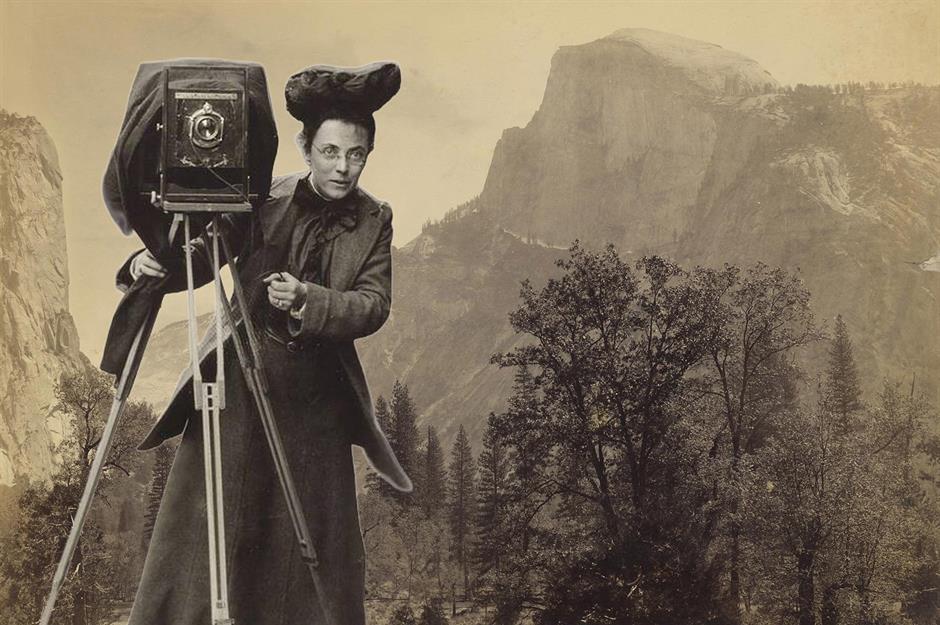
It's difficult to imagine a world without photography today – capturing snaps of iconic landmarks and landscapes is one of the great joys of traveling. But photography was only invented in the 1830s, gaining in popularity and accessibility through the 19th century.
Click through this gallery to see our special collection of early photos that offer a glimpse into the America of yesteryear...
1839: self-portrait of Robert Cornelius, Philadelphia
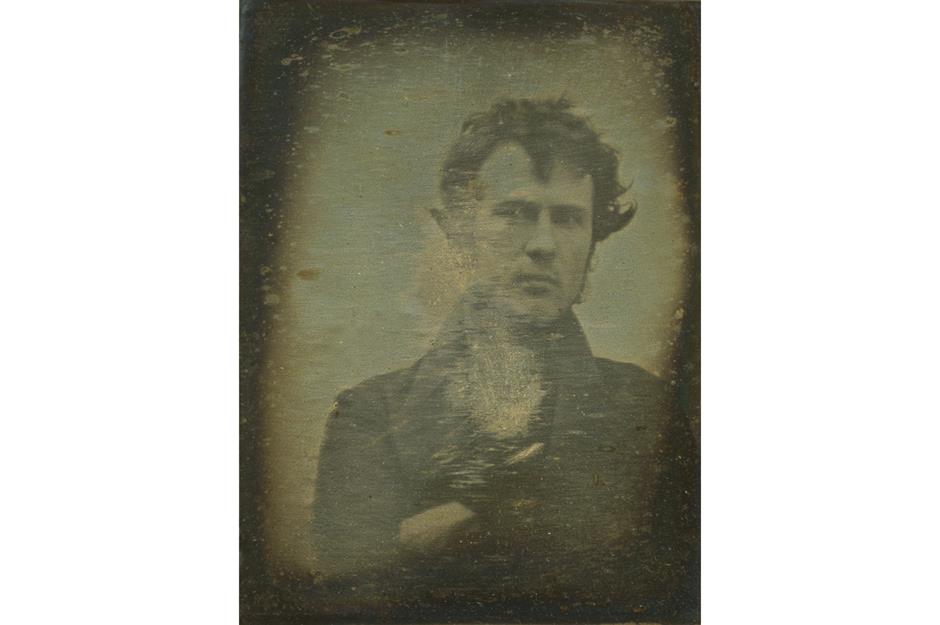
This brooding image of American photography pioneer and amateur chemist Robert Cornelius might be the world’s first ever selfie. Cornelius posed for the self-portrait at the back of his family’s silver-plating shop in Philadelphia.
To get the shot, he removed the lens cap from his camera and had to run into the frame, waiting in place for a minute before covering the lens again. He wrote on the back of the image: "The first light picture ever taken. 1839."
1851: abandoned Gold Rush ships, San Francisco

As word spread about the discovery of gold in California in 1848 people from all over America – and the world – descended upon San Francisco to seek their fortune.
Gold fever afflicted the crews of the ships that brought them to California too. This photo of Yerba Buena Cove taken in 1851 shows the scores of abandoned ships left behind to rot after sailors headed off to the goldfields in the hope of striking it lucky.
1852: miners during the California Gold Rush
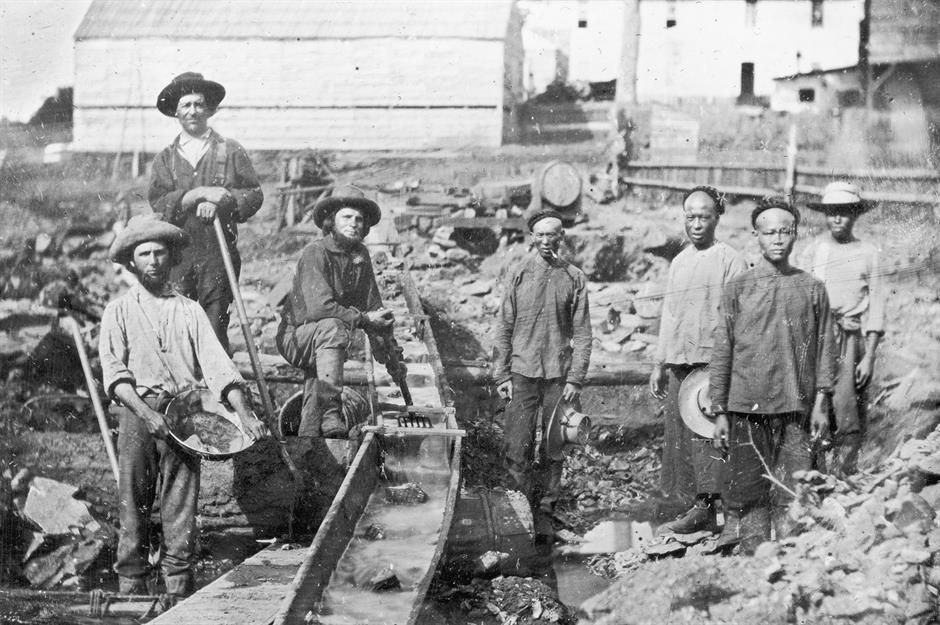
The Gold Rush went on to change the face of the USA in the 19th century, as migrants pushed westward to prospect for precious metal and to work in the mines that were mushrooming across the region.
Miners are pictured here in California's Auburn Ravine region back in the 1850s.
c.1860s: Civil War damage in Charleston, South Carolina
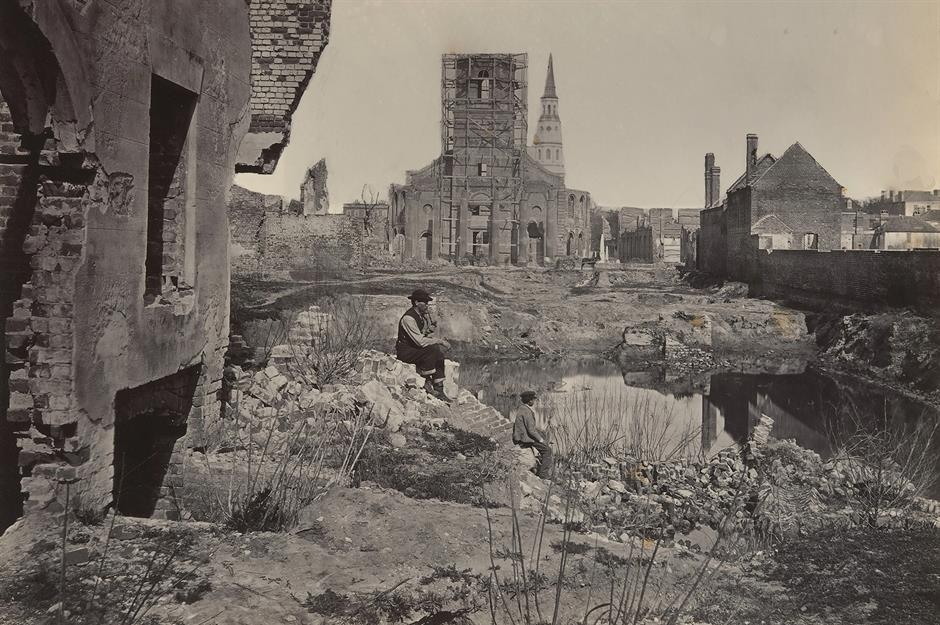
The 1860s were a turbulent time and though plenty of paintings show the devastation of the Civil War (1861–1865), it's even more visceral when captured in a photograph.
Charleston was pivotal during the conflict as Union and Confederate forces struggled for power: ultimately Union troops blitzed the Southern city and a fire ripped through it in 1861. A pair of men are pictured amid the wreckage in this photo from the early 1860s.
c.1860s: New York City's Wall Street in the 1860s
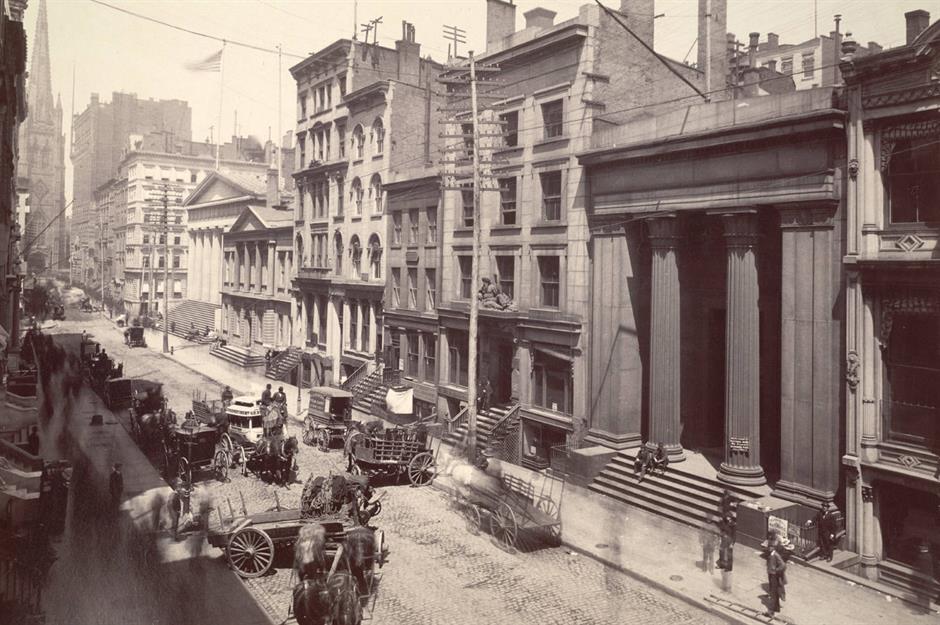
After the war, many veterans poured into New York City in the hope of finding work. However, a recession in 1866 meant that employment was difficult to come by.
This photo from the 1860s shows a very different Wall Street to the one we're familiar with today. There are horse-pulled carts in place of tourists and taxi cabs, and soaring buildings like 40 Wall Street are yet to pierce the skies.
c.1860s: a view of Nashville
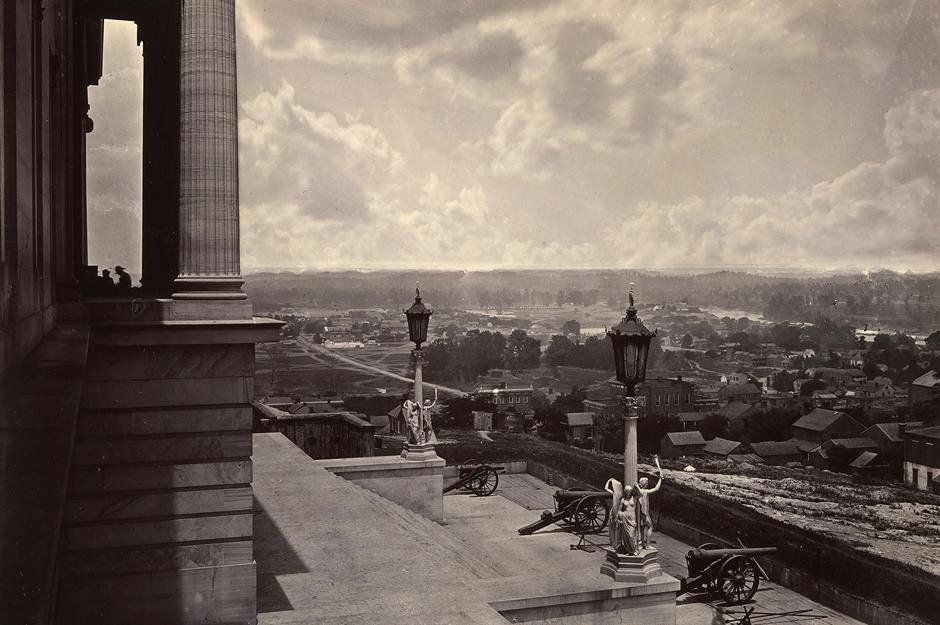
New York isn't the only city that's almost unrecognizable in 19th-century photos. Today Nashville is associated with winking neon lights, lively honky tonks, and lofty skyscrapers like the 'Batman Building' (officially the AT&T Building).
However, this 1860s view from the Capitol shows low-rise homes interspersed by trees and backed by wilderness.
Love this? Follow our Facebook page for more historic photos and travel inspiration
c.1860s: a Union field hospital in Michigan
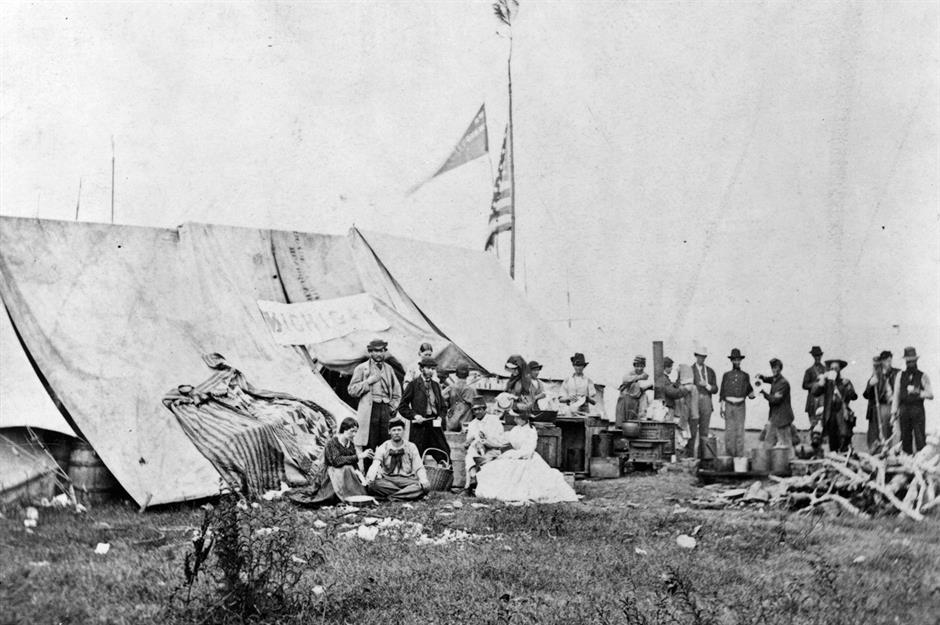
This early photo captures a familiar sight in America during the 1860s. It shows a Union field hospital that has popped up in a rural area of Michigan. Here nurses from the Michigan Soldiers' Relief Society are gathered around the troops.
1860: Boston from above
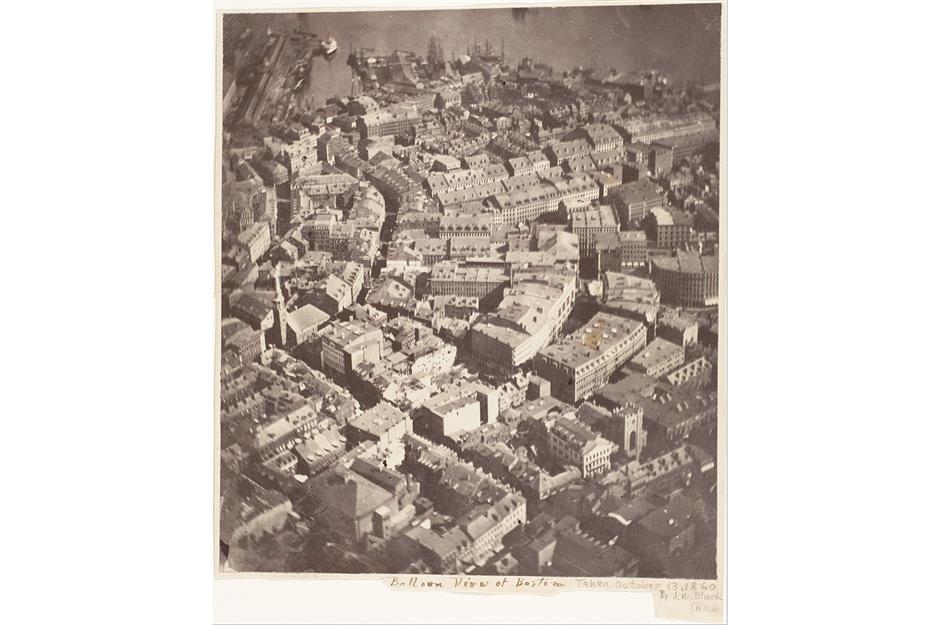
Entitled ‘Boston, as the Eagle and the Wild Goose See It,’ this image is one of the oldest surviving examples of aerial photography – and likely the earliest such photo ever taken in America.
Captured from a hot air balloon by Boston-based photographer James Wallace Black, the scene includes landmarks many residents might recognize today, including the Old South Meeting House, where the Boston Tea Party was planned almost a century before this photo was made.
1864: a Civil War-ravaged house in Atlanta, Georgia
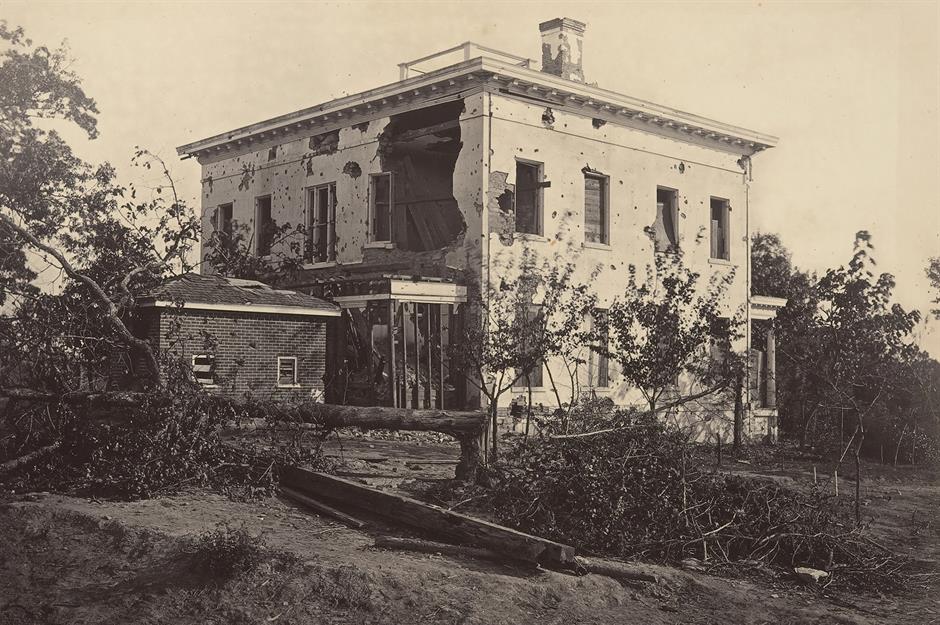
Another haunting photo from the Civil War, this one shows the Ponder House in Georgia's capital, not long after the Battle of Atlanta (July 22, 1864). Confederate troops had occupied the house and it was shelled by Union forces.
In this 1860s shot, you can see the façade riddled with bullet holes and entirely destroyed in one area.
1864: slave auction house in Atlanta
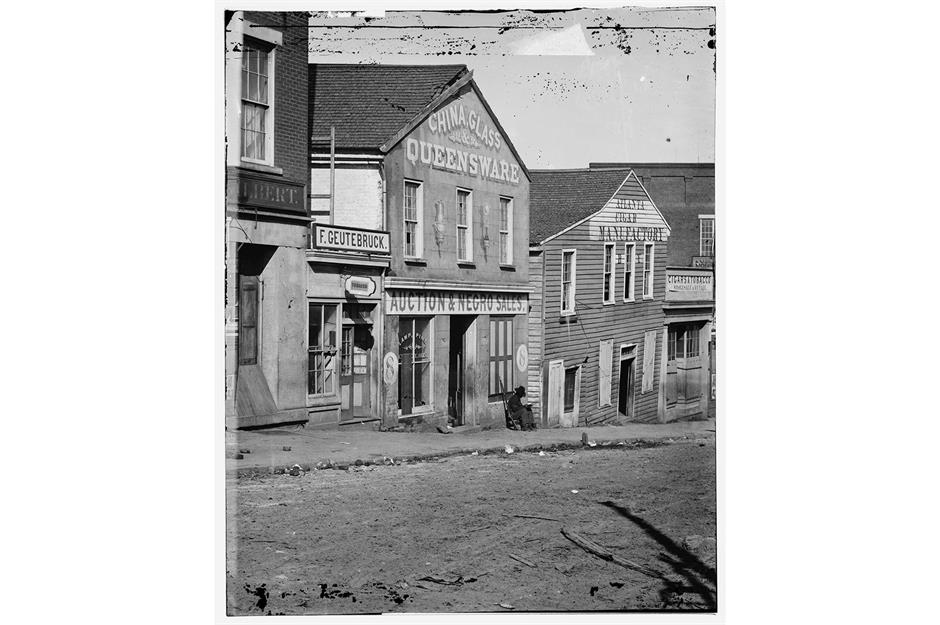
This photo is one of many taken by George N Barnard, official photographer of the Chief Engineer’s Office, during the Union occupation of Georgia during the American Civil War. It shows an African-American Union soldier, rifle at his side, posted at a slave auction house on Whitehall Street in Atlanta.
When in use, the building hosted prospective buyers as they bid for enslaved peoples, who would have to stand on a platform to be judged and inspected before the auction began.
1865: a view of Yosemite Valley

Established way back in October 1890, Yosemite National Park was the third in the system to be designated. But this 1860s shot predates even that.
The photo captures the spellbinding Yosemite Valley, which Mother Nature carved out over millennia and which looks much the same today. Now this is one of the most popular photo ops in the park.
1868: Indigenous peoples in southeastern Alaska
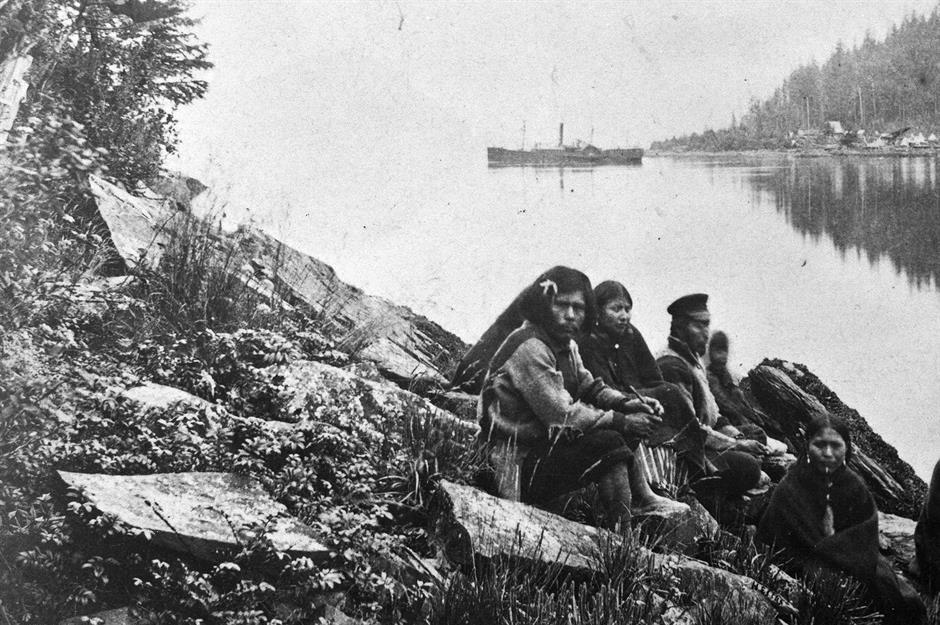
From budding metropolises to the wilds of the Frontier State: this image dates back to 1868 and shows a group of Indigenous peoples sitting on Alaska's Rock Cod.
In the background, you can make out Fort Wrangle and Wrangell Island. This area of southeast Alaska has long been inhabited by the Eyak, Haida, Tsimshian, and Tlingit tribes.
1869: Mammoth Hot Springs in Yellowstone National Park
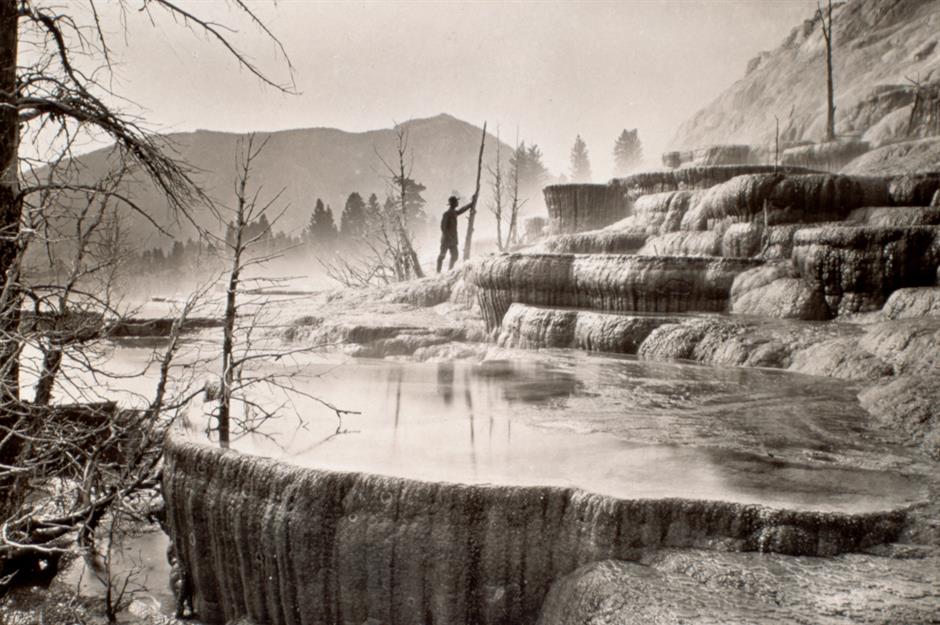
America's cities shifted and swelled during the 19th century – but there's something remarkably comforting about Mother Nature's constancy when she's left to her own devices.
This breathtaking shot from 1869 shows Yellowstone's Mammoth Hot Springs (prior to the park's founding), their travertine terraces not so different from today.
c.1870s: America's Capitol Building in the 1870s
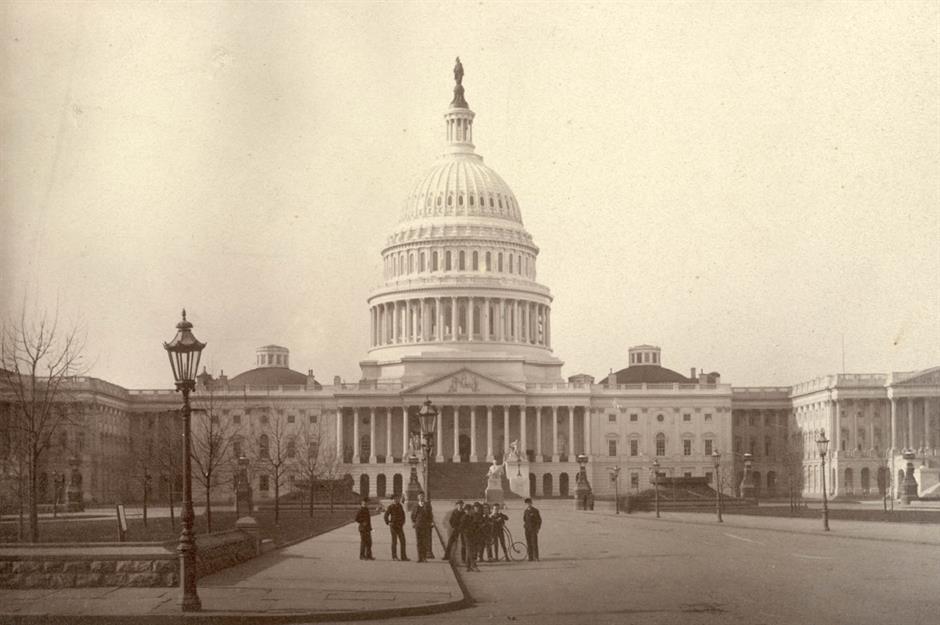
From America's revered natural wonders to one of its most iconic landmarks – the Capitol Building has been tinkered with plenty since its cornerstone was laid in 1793.
It's instantly recognizable in this photo from the 1870s, though. The image was taken after the erection of the Capitol's distinctive cast-iron dome in the 1850s–1860s. A huddle of men pose before the monument.
1870: street view in Helena, Montana
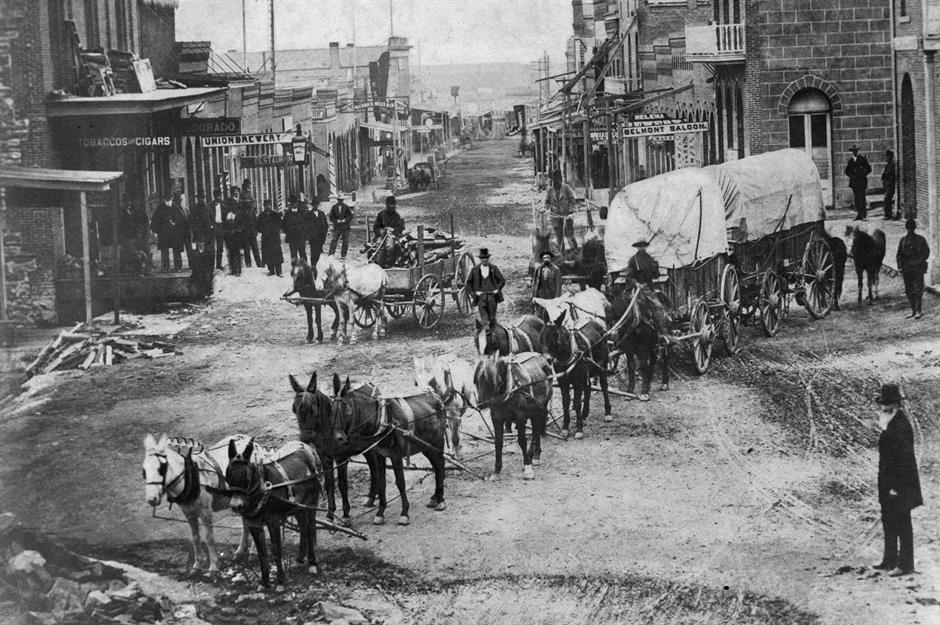
Montana – known as 'Big Sky Country' – is about as close to the old Wild West as you'll get when traveling through the States. Helena was designated the state capital of the Montana Territory in 1875, after growing up during the Gold Rush in the 1860s.
It's pictured here when it was a 19th-century boomtown filled with horse-pulled carts and saloons.
1871: Hayden Geological Survey at Yellowstone National Park
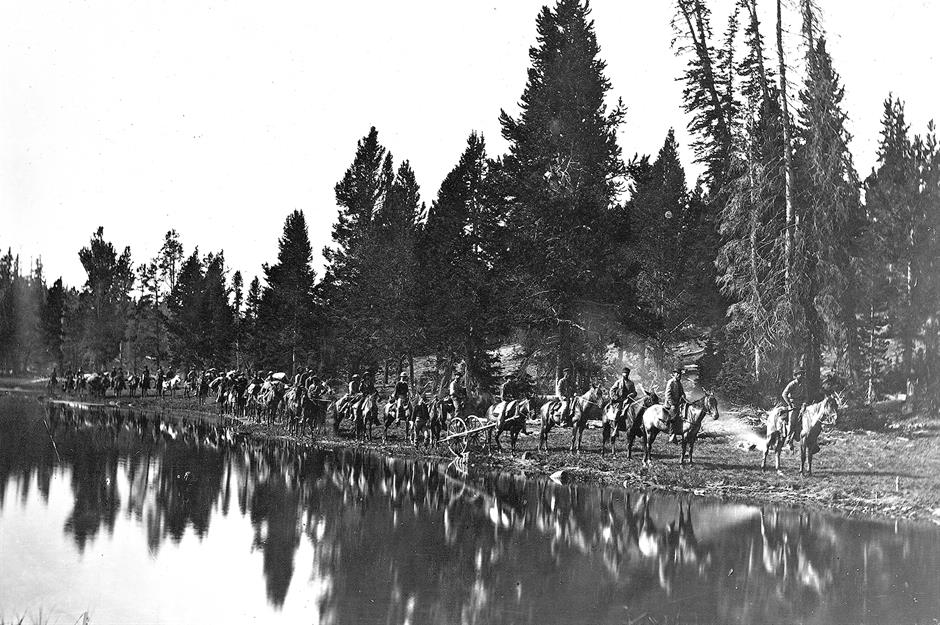
This photo also predates the founding of America's first national park. It captures the team from the Hayden Geological Survey of 1871 who explored and surveyed the land that would ultimately become Yellowstone.
Their pack train is papped here beside Mirror Lake, a glittering natural wonder that lives up to its name.
1871: the first boat on Yellowstone Lake
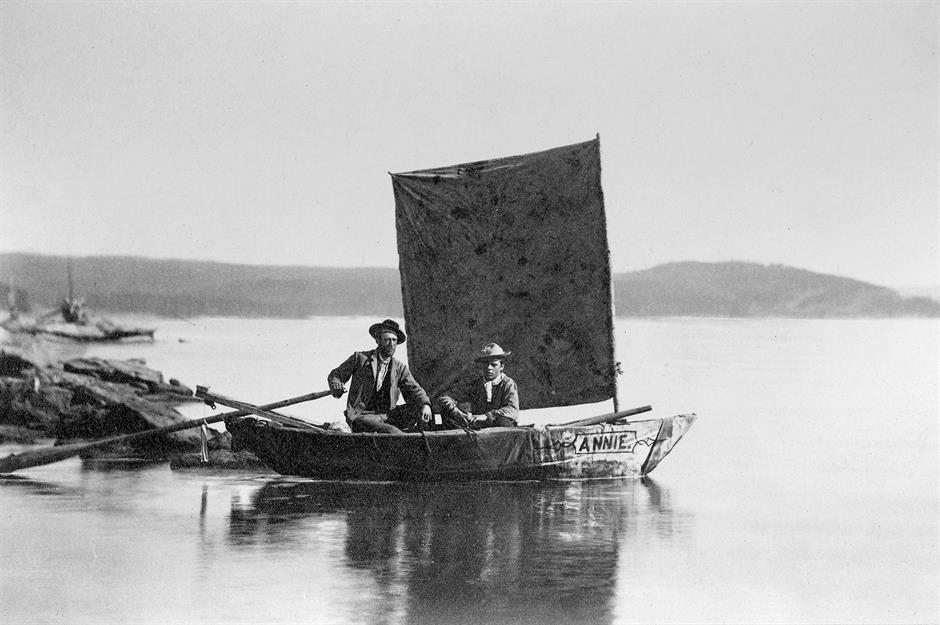
Today, Yellowstone National Park is a recreational hotbed, with travelers coming from far and wide to hike and bike, and to boat on Yellowstone Lake. But in the park's early days, folks were only just getting used to Yellowstone's potential for adventures.
The Annie (pictured here in 1871) is purportedly one of the first-ever boats to be launched on Yellowstone Lake.
The most beautiful and remote piece of wilderness in your state
1874: Shoshone Falls in Idaho
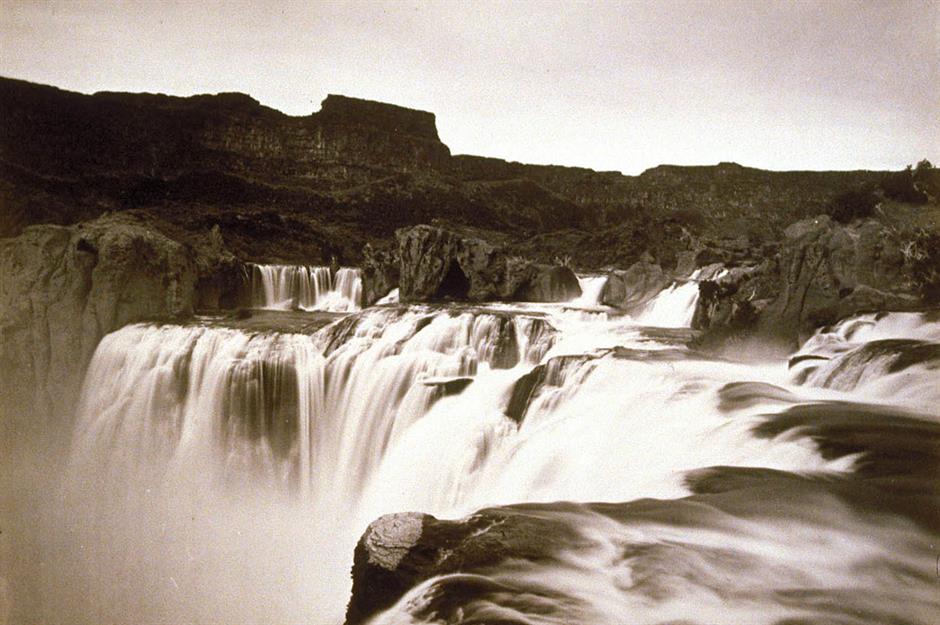
Here's another image capturing Mother Nature's enduring beauty. A cascade on Idaho's Snake River, Shoshone Falls is often dubbed the 'Niagara of the West.'
This photo was taken in 1874 – and if you snapped one from the same vantage point today, the thundering waterfall would likely look much the same.
1877: Fourth of July celebrations in South Carolina
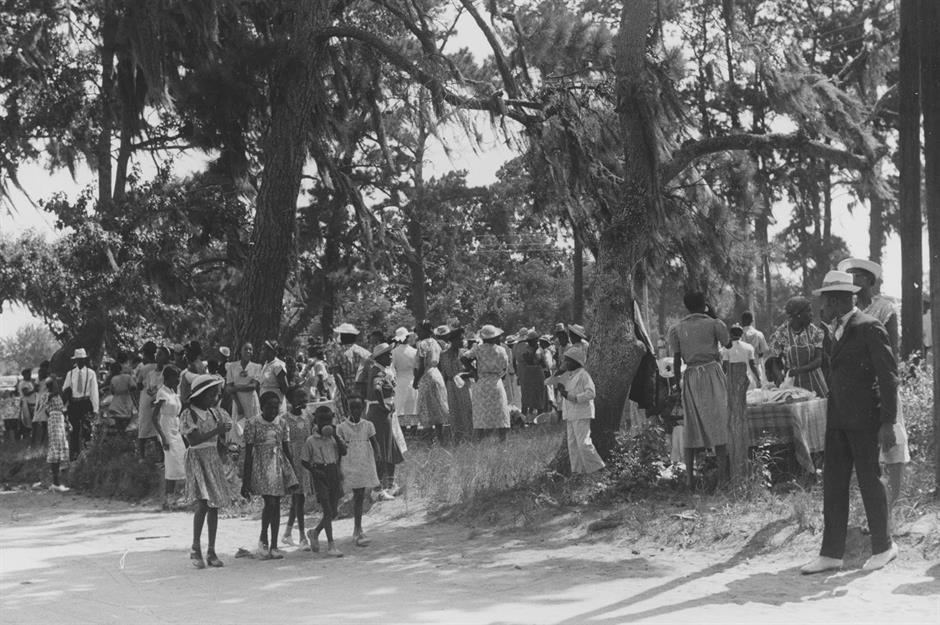
Sticking with the 1870s, this South Carolina photo sits in stark contrast to the image of a ruined Charleston captured just a decade ago. Here the folks of St. Helena Island gather under the Spanish moss to celebrate American Independence Day in 1877.
Notice the fine dress and the table of food being prepared to the right, likely heaving with Southern goodies.
c.1880s: travelers drive through a tree tunnel in California
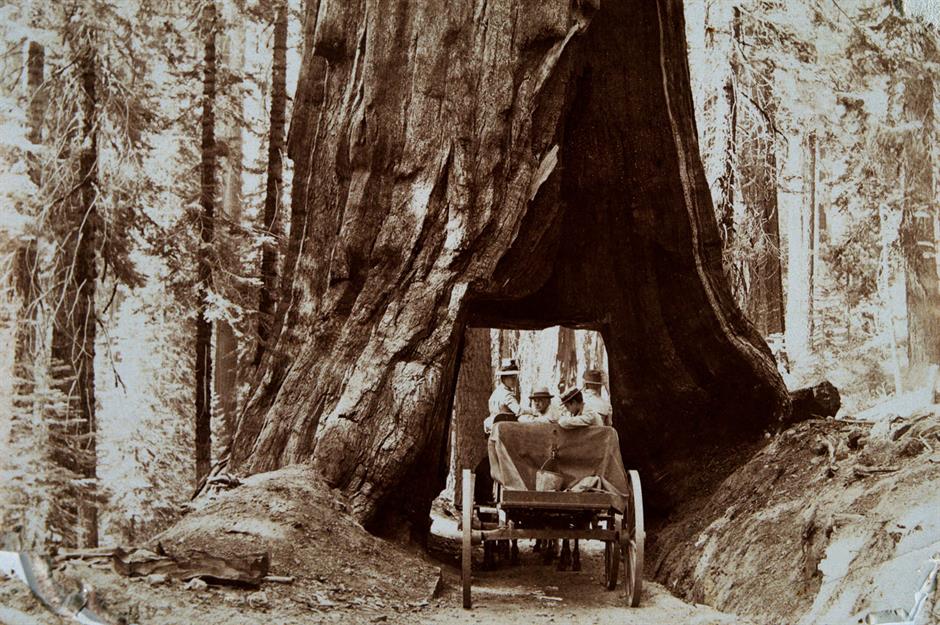
Fast-forward to the 1880s and to more of America's dazzling natural wonders. Pictured here is the Wawona Tree, a soaring sequoia tree that had a tunnel cut through its base in 1881.
Sadly, the weakened tree fell during a harsh winter in the 1960s. You can still see the fallen tree in Yosemite's Mariposa Grove, but photos like these are all that's left of it standing in all its glory.
1880: A cowboy saloon in Miles City
Real life saloons in America’s Wild West were very different to those portrayed in Hollywood westerns. Most were rough and tumble shacks in the middle of nowhere where the entertainment was provided by a tumbleweed rolling through town.
Like Bob Saloon in Mile City Montana, photographed here in 1880. The saloon is long gone, but you can still enjoy Golden Grain Belt beer across the Midwest, courtesy of Schell's Brewery in New Ulm in Minnesota.
1884: tornado near Howard, South Dakota

Touted by some sources as the oldest known photo of a tornado, this foreboding image was taken about 22 miles southwest of Howard in South Dakota on August 28, 1884.
Though they are most common in the Central Plains and southeastern regions of the US, tornadoes have been recorded in all 50 states, and are responsible for the deaths of around 60 people each year.
1885: a railroad in the Cascades
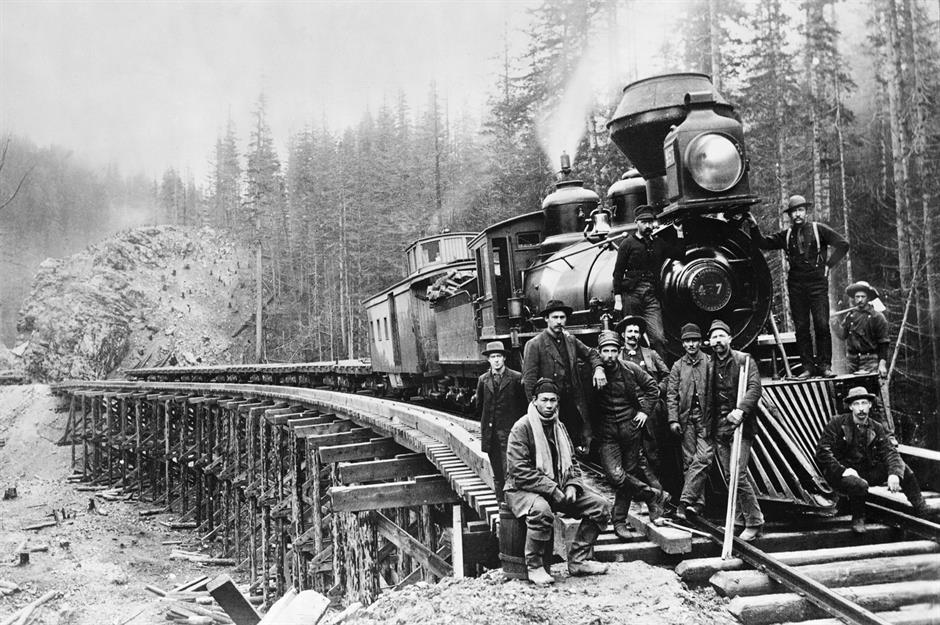
America's railroads were built at a rapid pace through the 19th century and they were especially vital in regions such as the Pacific Northwest, which had a thriving logging industry.
Pictured here is a group of construction workers laboring on a railroad as it crosses the Green River, on the West Slope of the Cascades in Washington state.
1885: the beginnings of the Statue of Liberty
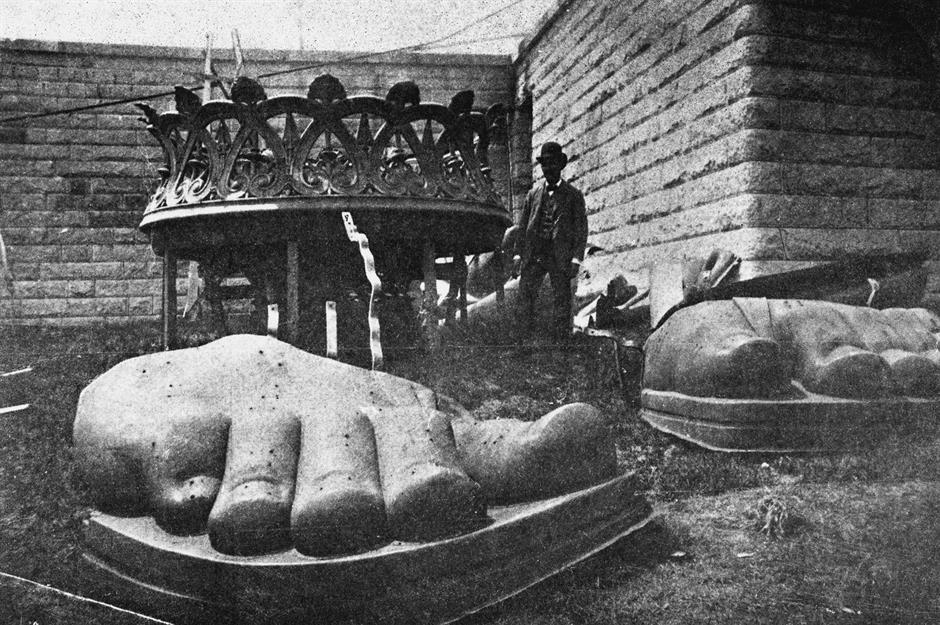
Can you tell which monument these mammoth components belong to? This 1885 photo captures the giant toes and torch of the Statue of Liberty, as she waits to be assembled on her pedestal on Bedloe's Island.
She would finally be completed in April 1886.
1886: Homestead family in Nebraska
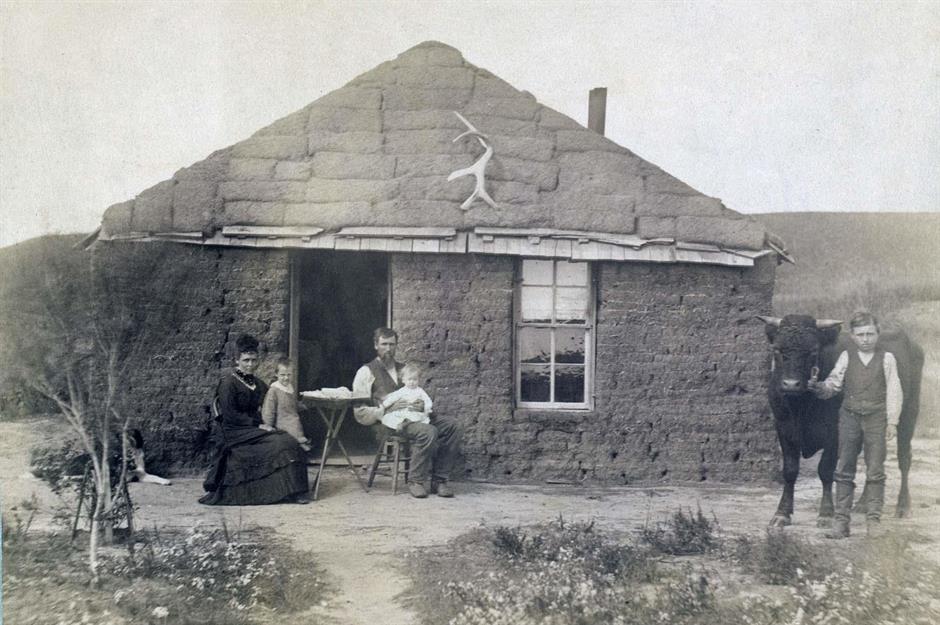
Proposed in 1860, the Homestead Act that would allow free land to settlers to encourage them to move west, was vetoed by pro-South President James Buchanan.
But just two years later, in the midst of a bloody civil war, Abraham Lincoln passed the act, granting land to those who lived on and 'improved' at least 160 acres. Here we see the Laulerman family outside their sod house homestead in Custer County, Nebraska, in 1886.
c.1889: Alaska's Treadwell Gold Mine
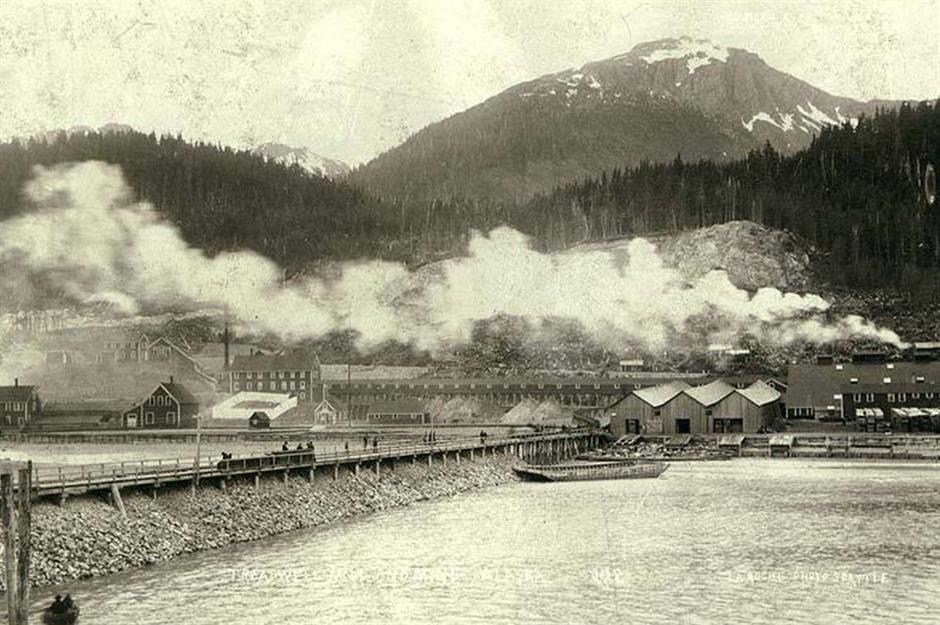
The 1890s would change Alaska forever, as the Klondike Gold Rush saw prospectors pour into the Frontier State and Canada's Yukon. But gold was mined here before the famous gold rush and the Treadwell Gold Mine operated on Douglas Island from 1881.
The busy mine, pictured here in 1889, was a hive of activity at the end of the 19th century, shifting some $70 million of gold during its operation.
c.1890s: American photographer Frances Benjamin Johnston
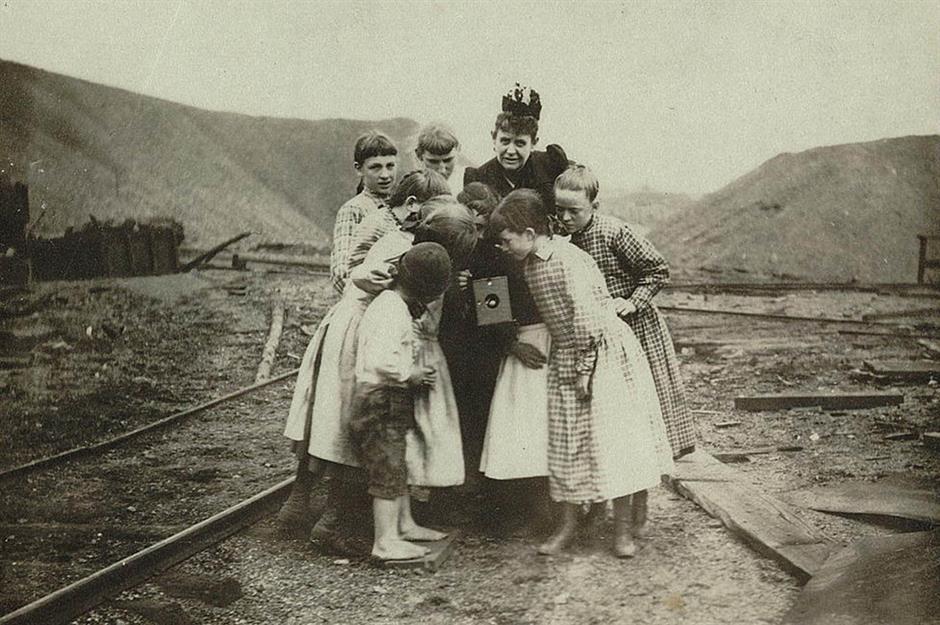
By the 1890s, photography in its earliest form had been around for more than half a century. Still, though, the whole thing remained something of a novelty. Here the lens is turned on itself.
The image shows one of America's earliest photographers, Frances Benjamin Johnston, as children gather around her to peer at her camera. Johnston was famous for her photojournalism, which spanned everything from social issues to architecture.
c.1890s: crowds at Coney Island in the 1890s
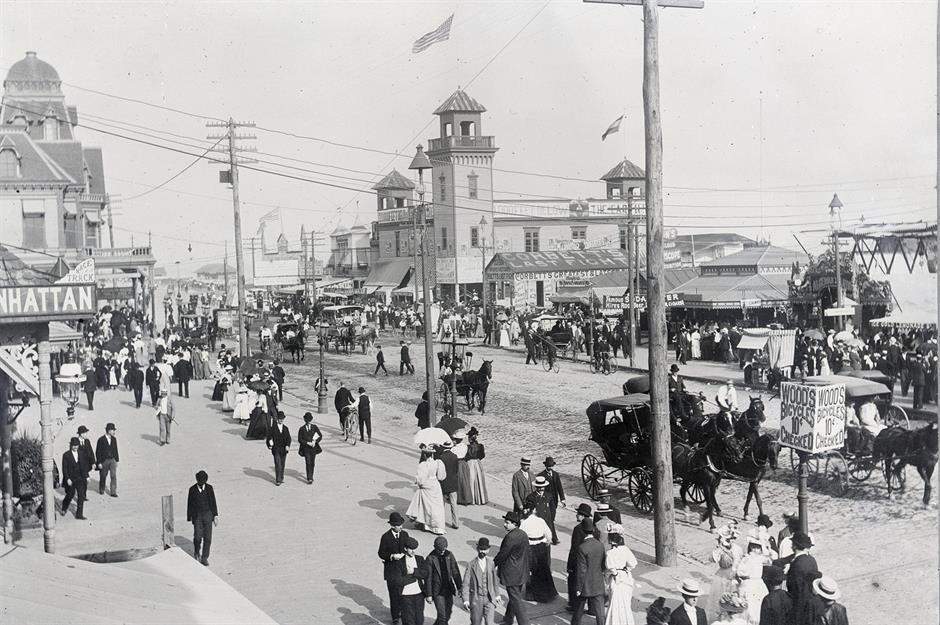
The latter part of the 19th century saw Brooklyn's Coney Island boom. Both Steeplechase Park and Sea-Lion Park opened in the 1890s (followed by Luna Park and Dreamland in the early 1900s).
Here vacationers and day-trippers are seen wandering Coney Island's main drag, which is lined with refreshment stops, hotels, and stores. The 'last fight' of heavyweight James J. Corbett is advertised on the roof of a street-side hut too.
c.1890s: man rowing in Boston Harbor
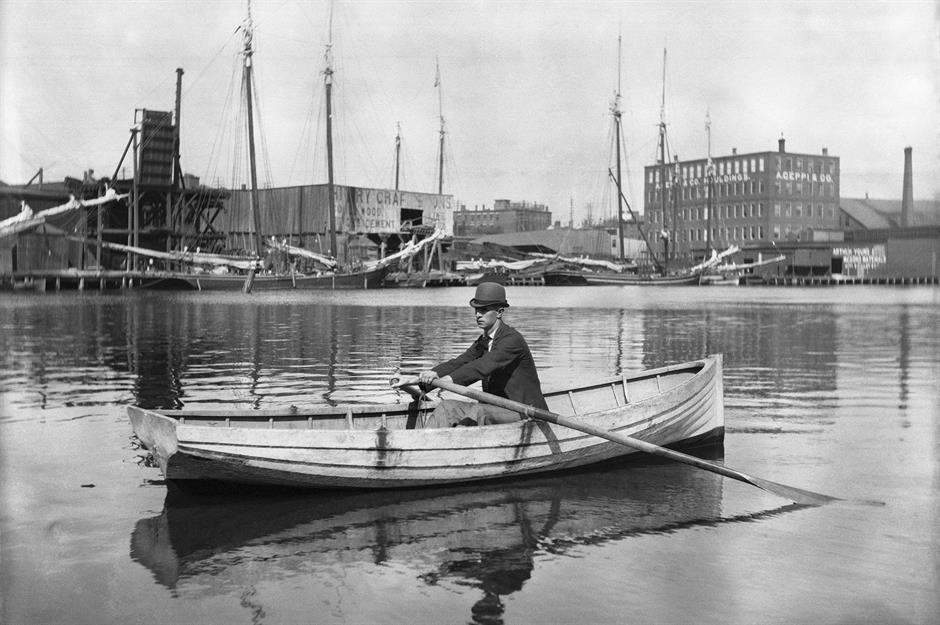
Boston Harbor has a prime place in America's history – not least as the site of the Boston Tea Party, which saw Americans launch chests of tea into the waters as a stand against British taxes.
Now it's a tourist hotspot, its banks graced with the glittering Institute of Contemporary Art and the glossy restaurants of the Seaport District. This nostalgic snap shows a man rowing on the glassy waters in the late 1800s.
1890: skating in New York City's Central Park
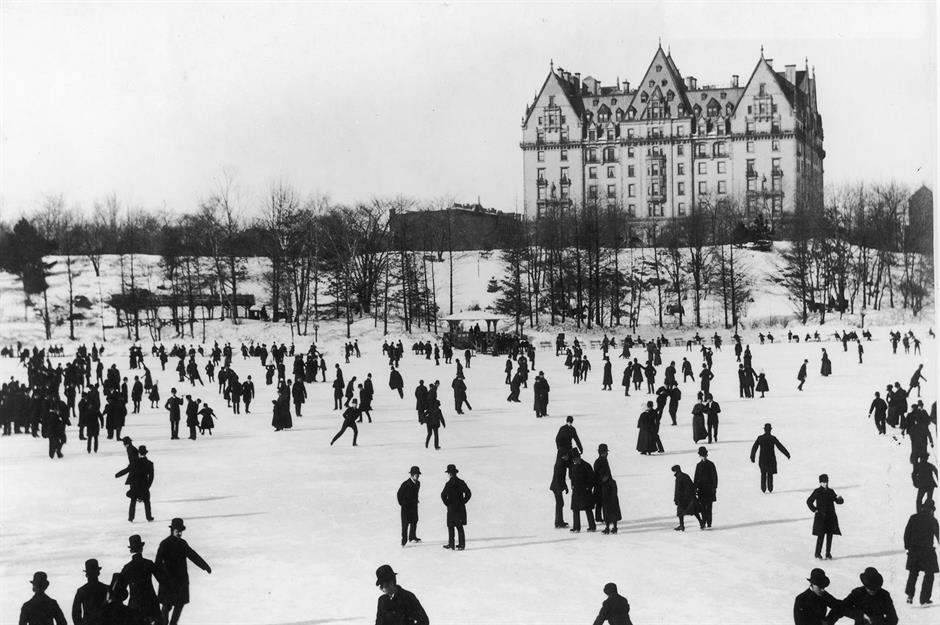
Ice skating in Central Park is one of the great joys of winter in the Big Apple and that was true during the 19th century too.
The Dakota Apartments (made famous by the assassination of John Lennon in 1980) can be seen rising above the frozen lake near West 72nd Street.
1890: the Cliff House in San Francisco
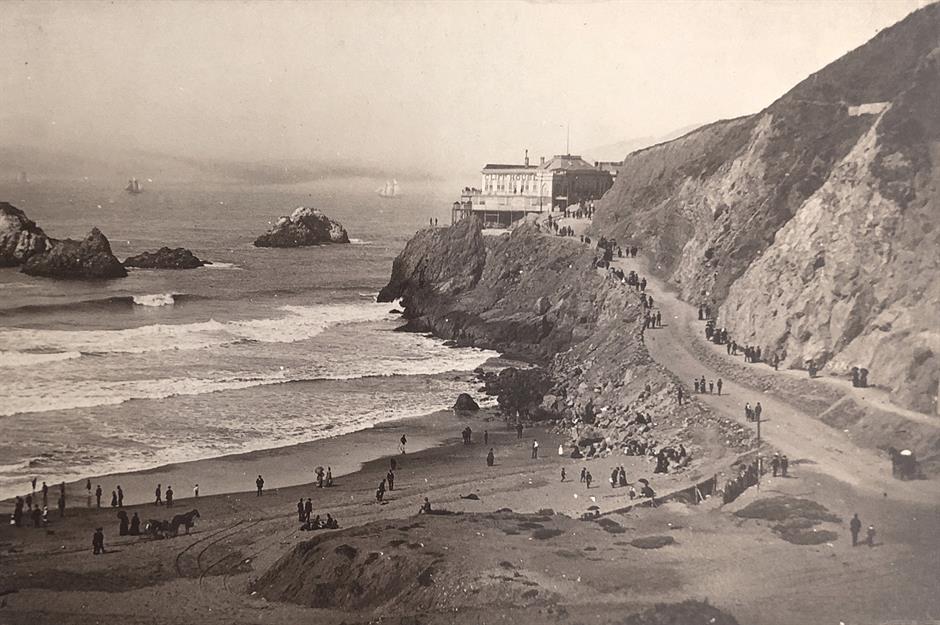
The grand Neo-classical Cliff House remains a striking sight on the San Francisco coast and it originally served as a sophisticated resort. The dramatic structure – though it stands today – has been destroyed by fire several times in its long history.
This photograph shows the original, which was constructed in 1863.
1890: New Orleans' French Market

Today, the French Market is a beloved tourist attraction in the Big Easy, drawing crowds of people eager to tuck into café au lait and beignets at Cafe du Monde.
But the market dates right back to 1791 and it's pictured here in 1890. We can't help but notice those rugged cobbled streets.
1891: a Lakota reservation in South Dakota
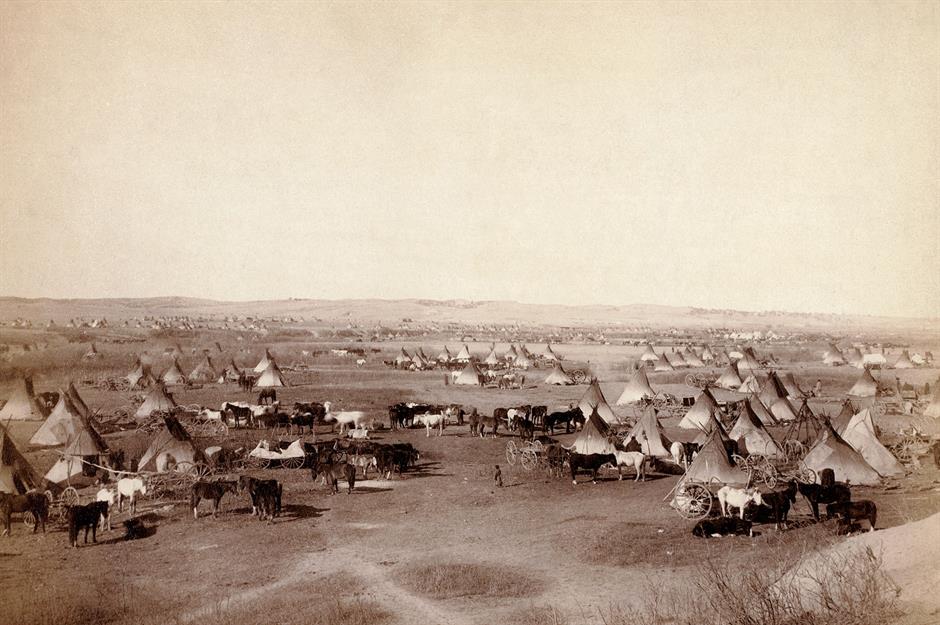
This 1891 photograph shows a sweeping view of South Dakota's Pine Ridge Reservation, home to the Indigenous Lakota peoples.
It takes on extra poignance when you consider that it was shot a year after the Wounded Knee Massacre (December 29, 1890), which saw hundreds of Lakota people killed at the hands of the United States Army.
1893: Chicago's first World Fair
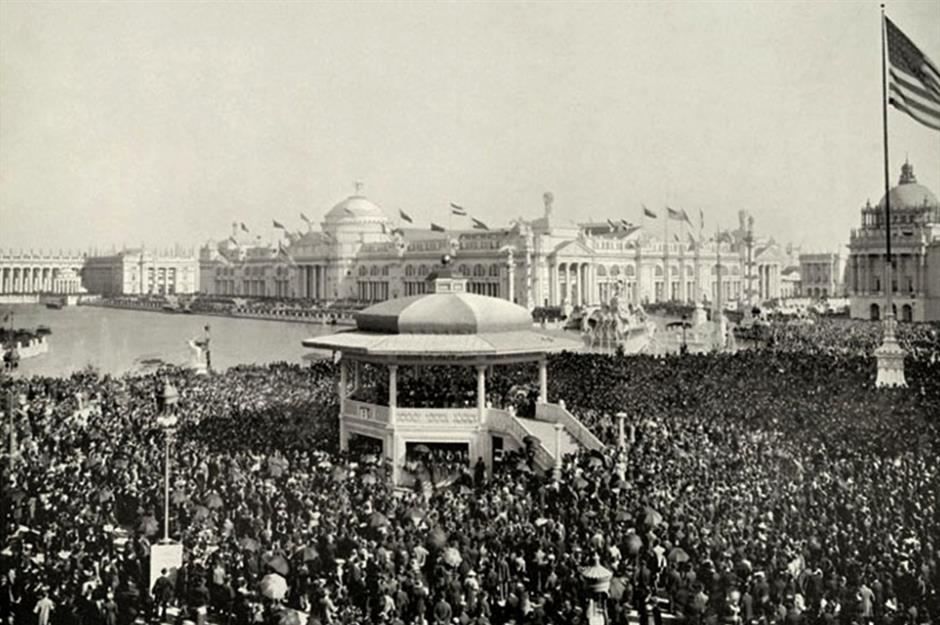
The Field Columbian Museum was originally established to hold artifacts from the 1893 World’s Columbian Exposition – the first to be hosted in Chicago. Here, the event is in full swing.
Impressive Neo-classical-style structures were built for the fair and the exposition site earned the moniker 'the White City' due to these grand, white buildings.
1895: street scenes in New Orleans

America's cities were changing shape through the 1890s. The Big Easy is famed for its street cars and though they date back to the 1830s, electric-powered versions made their debut in this decade.
They're captured here in 1895, alongside traditional horse-drawn carriages. Can you spot the glinting sign for the Orpheum Theater too?
1895: a San Francisco mail cart in 1895
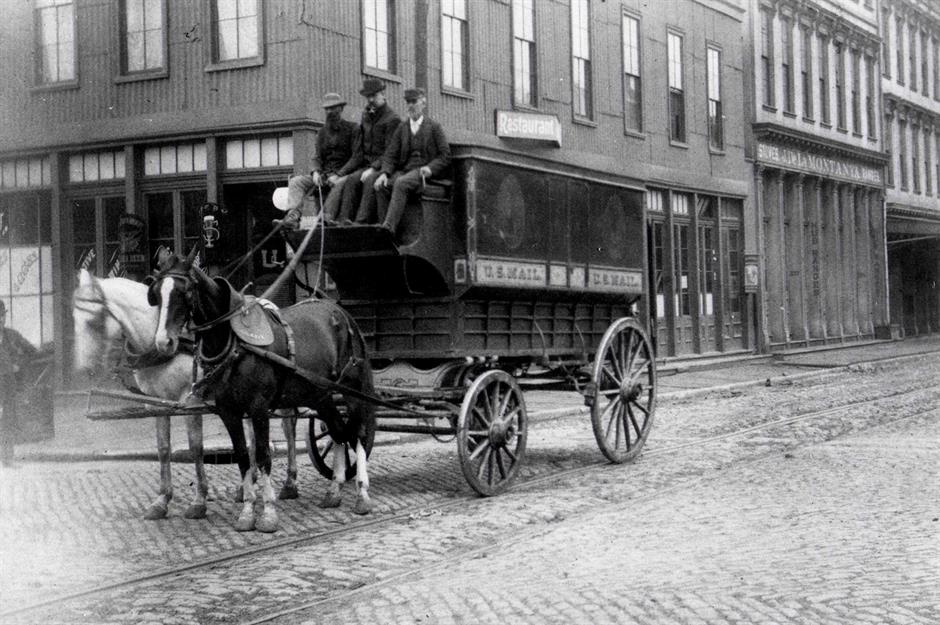
There were similar scenes out west in San Francisco too. This shot shows a horse-pulled California mail cart back in 1895 – rather different to the hulking white vans that pound the city's roads today. The cobbled street and vintage signs ooze nostalgia too.
1895: ferry to the Battery in New York City
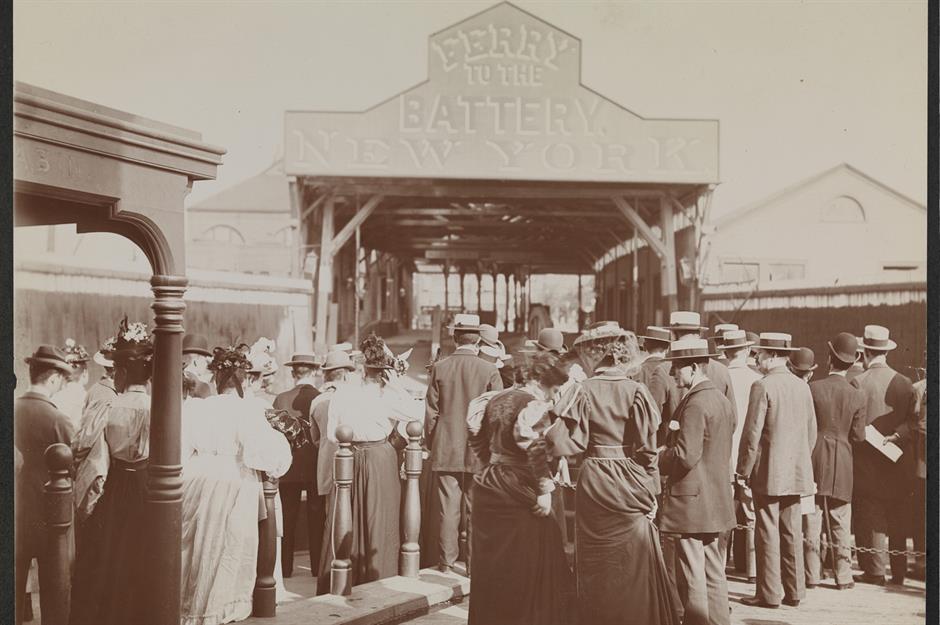
New Yorkers made the most of the water to get from A to B. This 1895 picture shows crowds gathering at the entrance of the ferry to the Battery, most likely at either Staten Island or Coney Island.
The Battery (once an important defensive site) offers expansive views of New York Harbor and visitors have been soaking up the vistas here since the early 18th century.
1896: extension of Flagler's Florida East Coast Railway
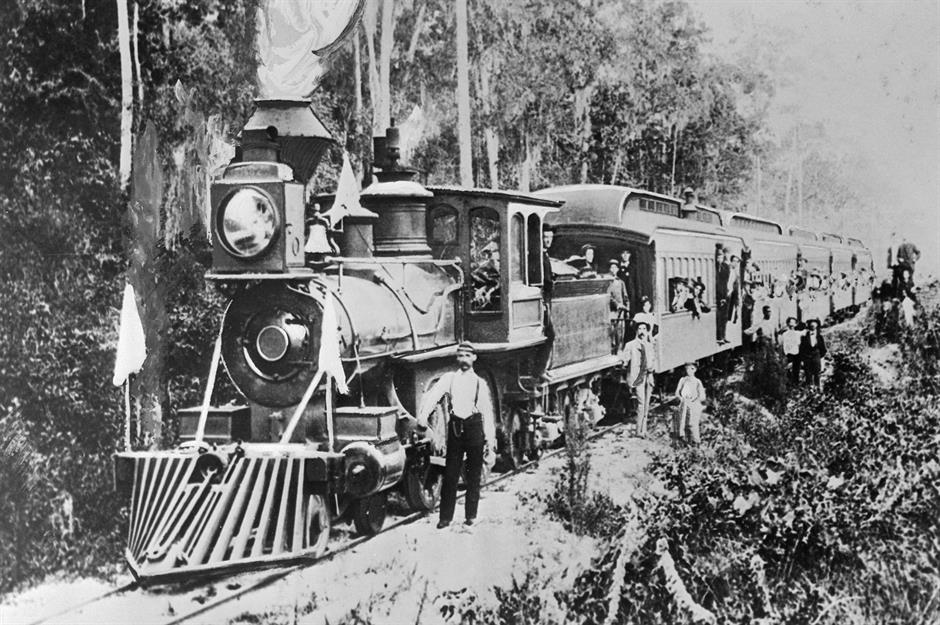
No American industrialist is better known than Henry Flagler and he is especially lauded for his development of the Florida East Coast Railway. The railroad is pictured here in 1896, after it was extended into Miami.
The arrival of the train service would turn Miami from a laidback town to a buzzing city, and it was incorporated in the same year.
1899: Hawaii's Iolani Palace
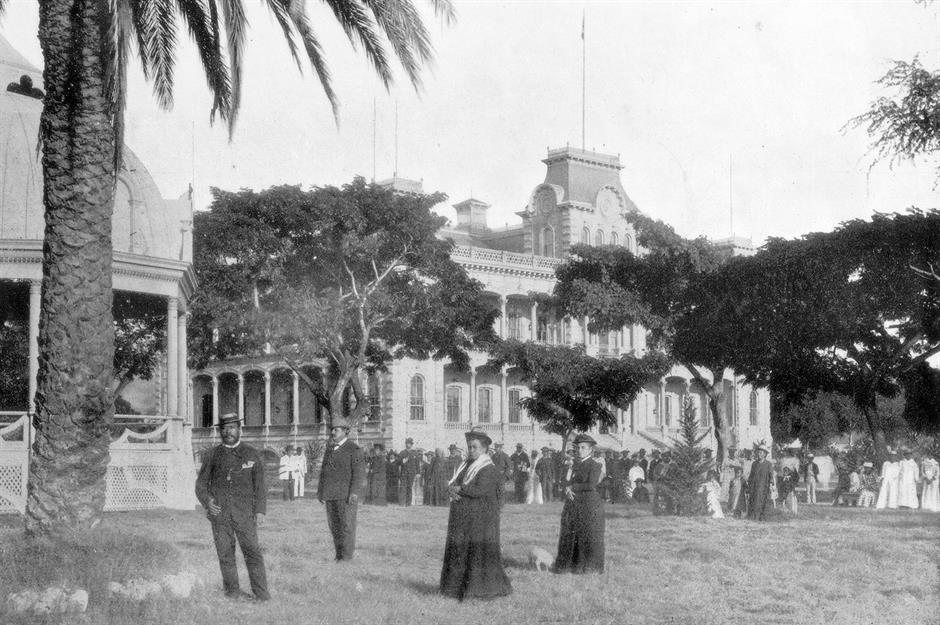
Over to the Aloha State and a rare sight in the USA. This photograph from 1899 captures the only royal palace in the United States, Iolani Palace, home to the Kingdom of Hawaii's monarchs until 1893.
King Kalakaua and Queen Lili'uokalani were the last royals that the palace ever housed.
1899: women outside Atlanta University
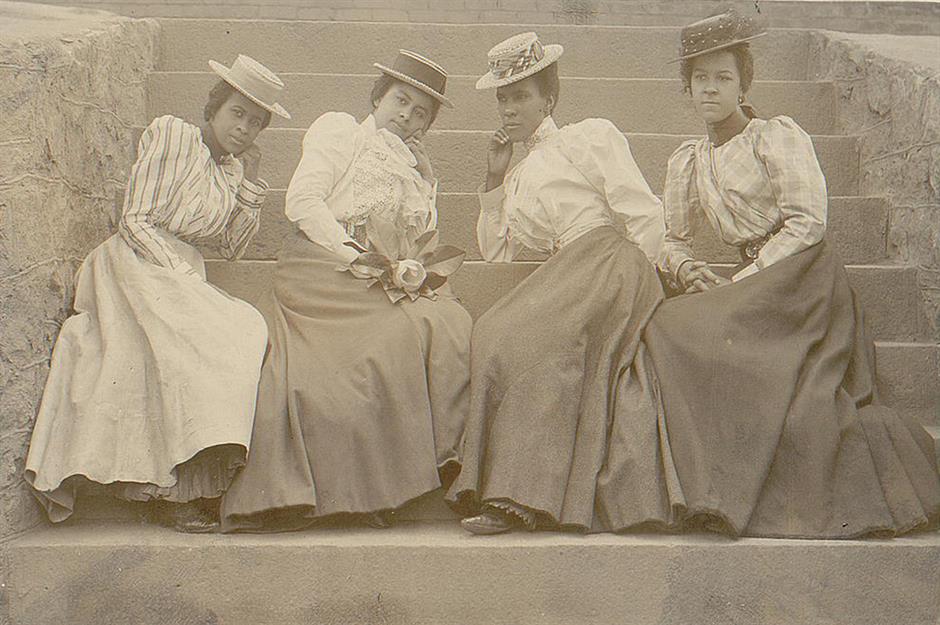
This 1899 shot was taken at another important American institution: Clark Atlanta University, then just Atlanta University, which was founded as the first Historically Black College or University (HBCU) in the Southern United States in 1865.
Here, four women pose on the steps outside the university.
1899: behind the scenes at Chicago's Field Museum
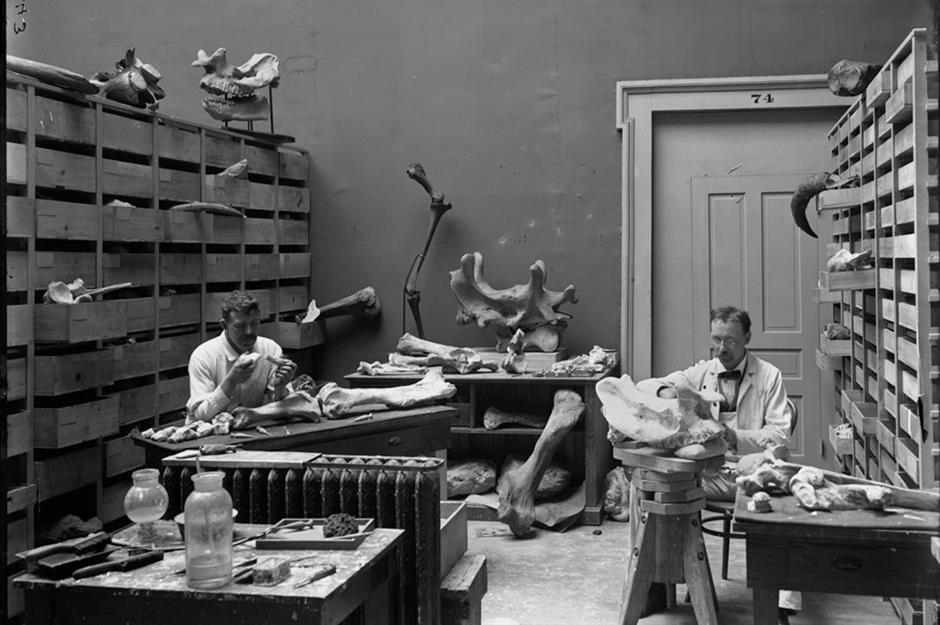
The advancement of photography also allowed fascinating, behind-the-scenes glimpses of some of America's finest institutions. This photo goes backstage at Chicago's Field Museum, established in 1894 as the Field Columbian Museum.
It shows paleontologists in the lab with a rhinoceros skull and other specimens in 1899.
1899: Havasupai women in the Grand Canyon
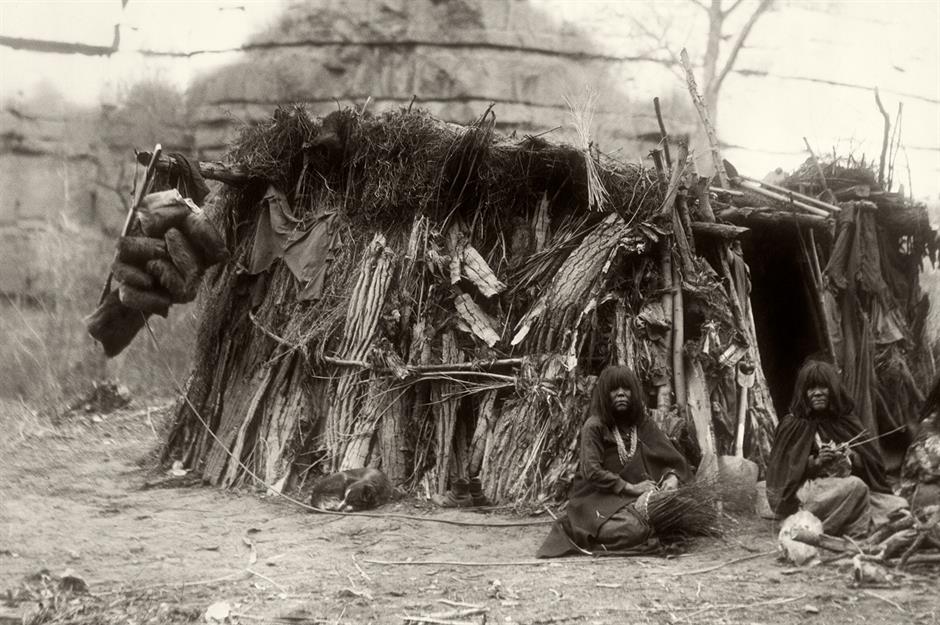
This photo predates the founding of Grand Canyon National Park by 20 years. The Havasupai people are thought to have lived in the Grand Canyon for some 800 years, and the park's founding in 1919 meant the tribe lost many acres of land.
Here, a group of Havasupai women are seen weaving baskets in 1899. Indigenous people still live in the Havasupai Indian Reservation today: just outside the boundary of Grand Canyon National Park, it's known for its incredible waterfalls.
c.1900s: beach view of Coney Island in the 1900s
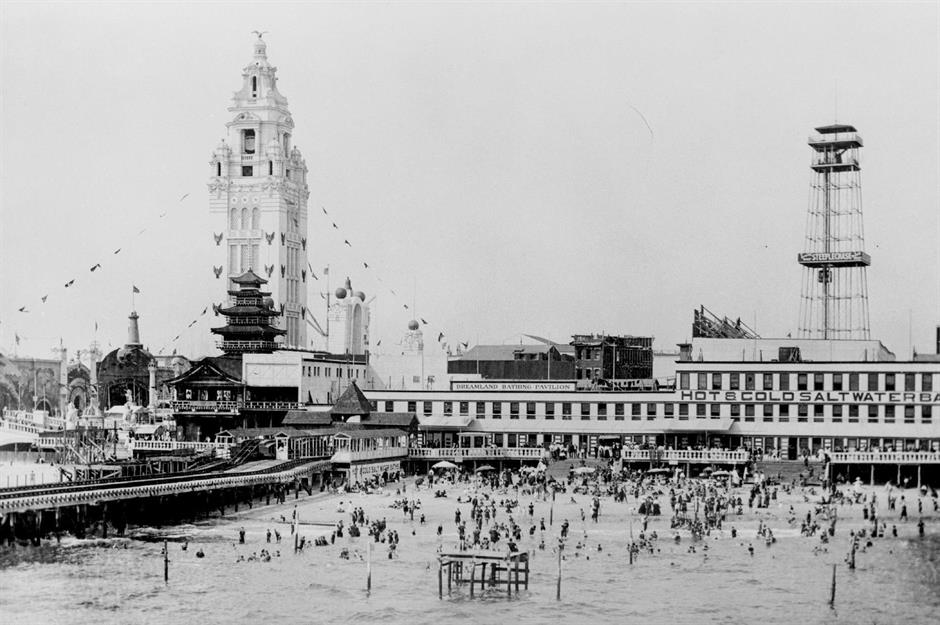
The fun continued into the 1900s and Coney Island is captured here at the turn of the century. Sun-seekers revel on the sandy beach and in the waters of Lower Bay, as the striking tower of Dreamland theme park rises in the background.
c.1900s: dance hall at California's Venice Beach
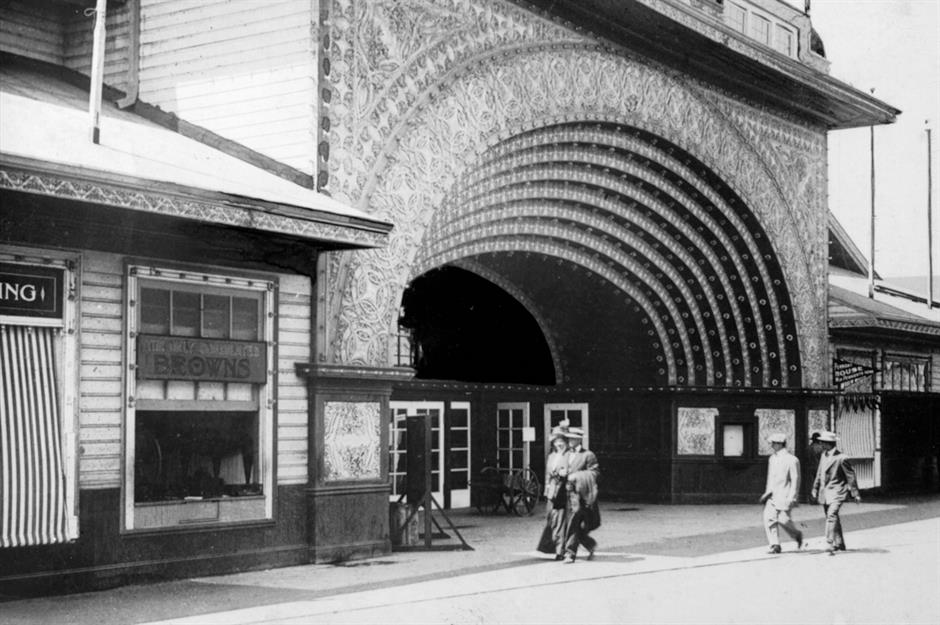
Turn-of-the-century California was no slouch when it came to vacation spots either, and Los Angeles' Venice has been attracting vacationers since the early 1900s.
Today, Venice Beach is known for its thronging crowds and eccentric street performers, but this early image shows a rather more laidback scene. An ornate dance hall is the focal point as visitors wander along the amusement pier.
c.1900s: Victorian women in the Grand Canyon
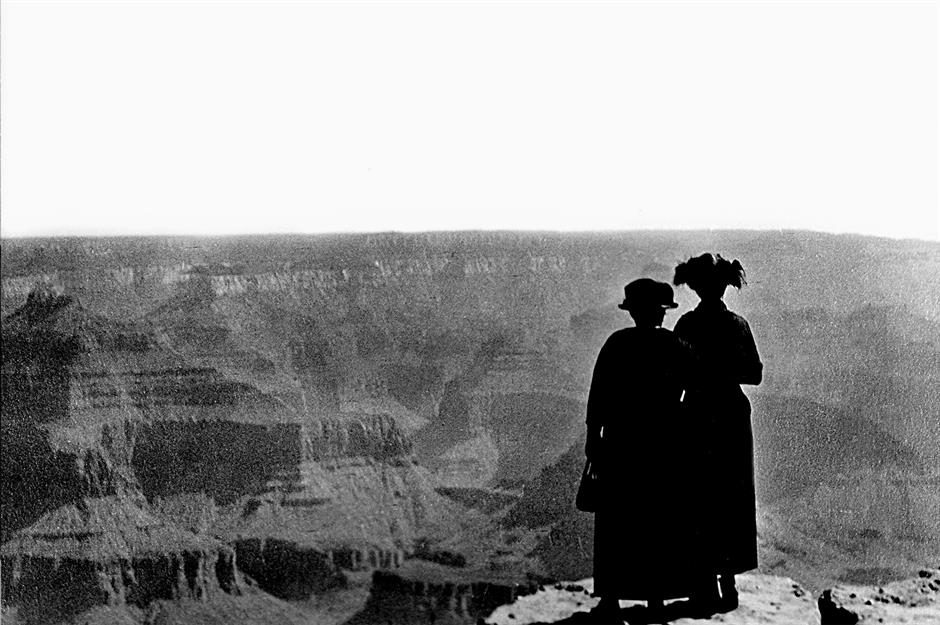
The Grand Canyon was millions of years in the making. And it looks barely changed from this circa 1900 photo. Here, two Victorian-era women gaze over the mighty landscape, silhouetted in their finery.
c.1900s: Las Vegas' Fremont Street in the early 1900s
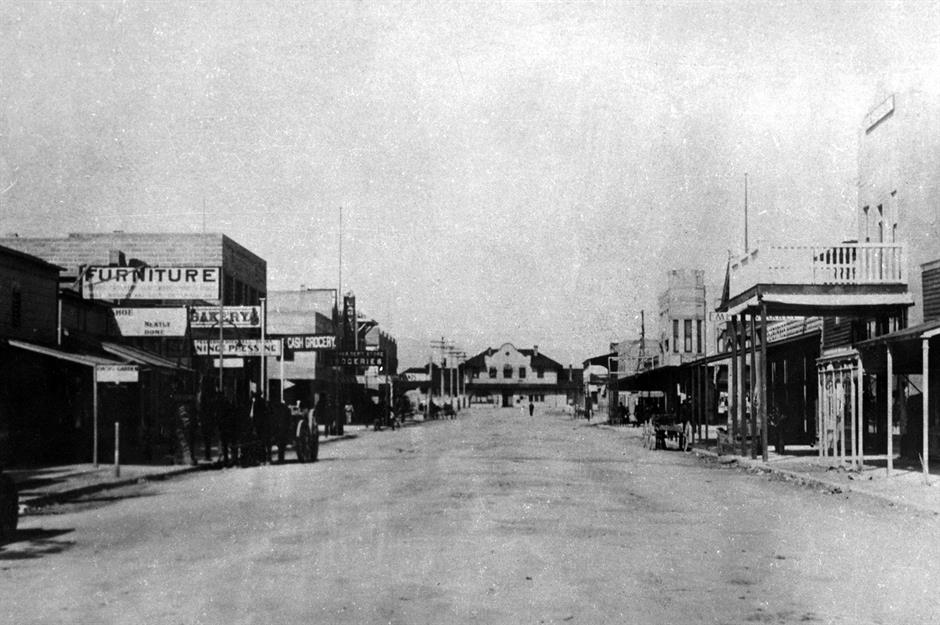
Some American cities are almost unrecognizable in their earliest photographs. Las Vegas was established in 1905 and this image pictures Fremont Street in its infancy: no soaring hotels, no neon-drenched casinos, no colorful cocktail bars.
Instead, you can see old western-style building fronts, and no-frills venues including a bakery, a grocery store, and a furniture store.
c.1900s: Sioux peoples riding on horseback
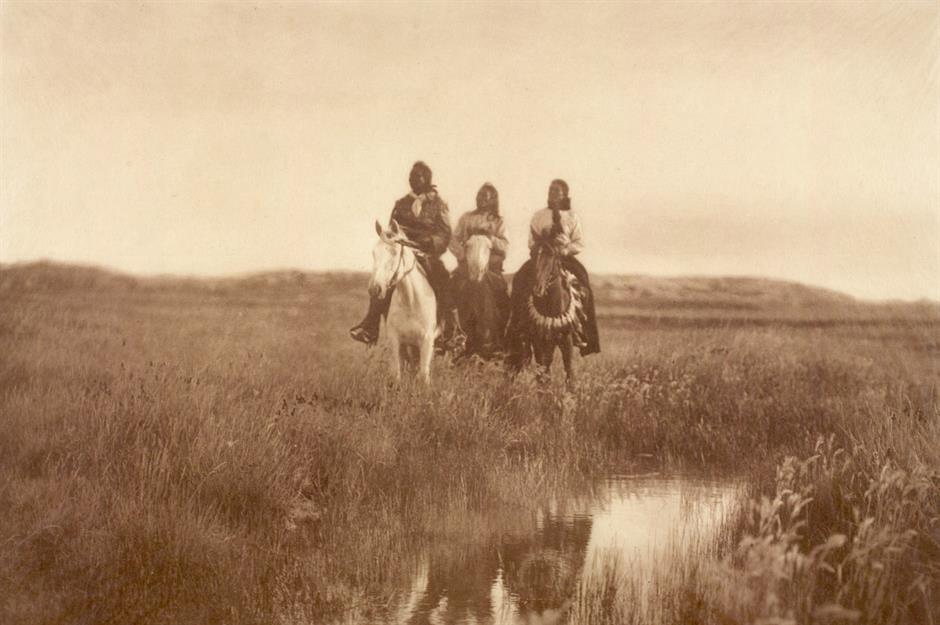
The beauty of America's Great Plains is on full display in this image from the early 1900s too. It captures a trio of Indigenous Sioux people riding on horseback through the rural Midwest.
c.1900s: Chestnut Street, Philadelphia

Chestnut Street is one of Philadelphia's most significant roads, today a busy thoroughfare that's still known for its collection of well-preserved architecture.
Some buildings date back more than 100 years and the street is captured here at the turn of the century, with horse-pulled carts in the place of cars, and plenty of well-dressed city dwellers.
1902: view of Goldfield, Nevada
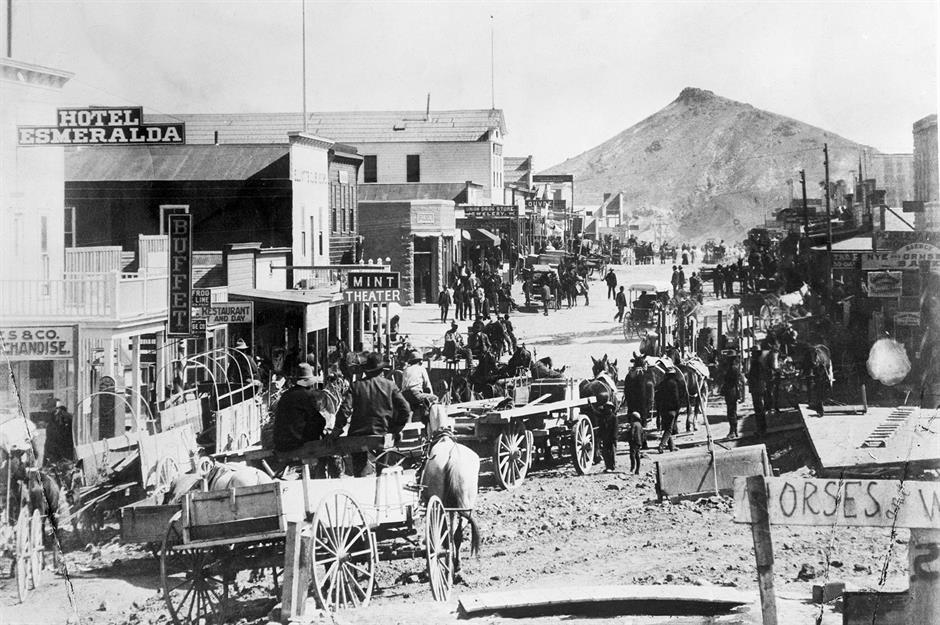
Nevada is defined by the gold rush and abandoned ghost towns still litter the state today. One city which grew up around the deposits was Goldfield, which is pictured here at the turn of the century, in the same year that gold was struck in the nearby hills.
It looks like a scene pulled straight from an old Western movie – spot the nostalgic Hotel Esmeralda and the Mint Theater.
1903: 'sail bikes' in Ormond Beach, Florida
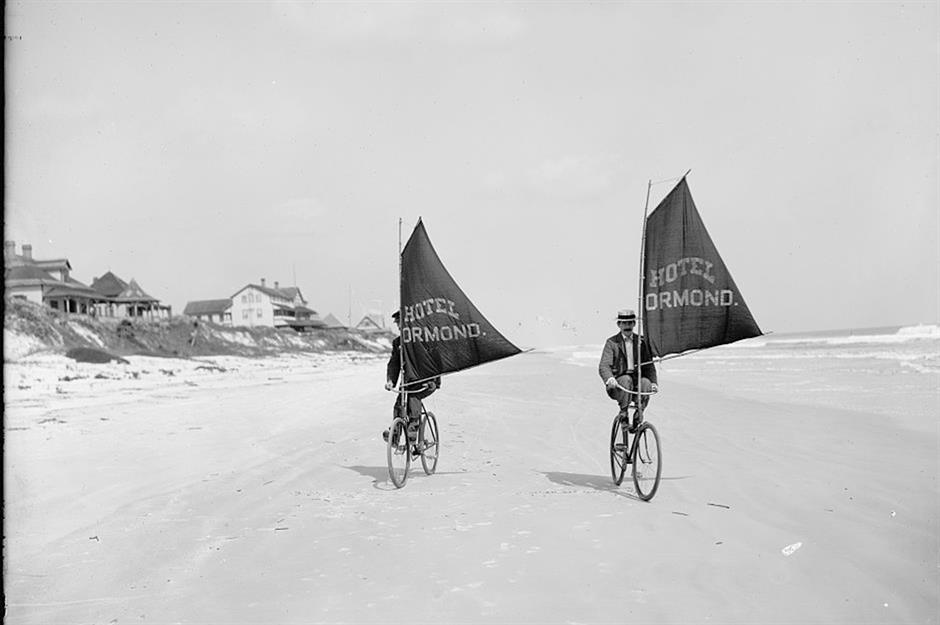
Farther down the East Coast, the Sunshine State was establishing itself as a major vacation spot too. Swish hotels were springing up, railroads were being built, and steamboat tours were gaining in popularity.
The main draw, though, was the powder-white beaches. This photo from 1903 captures a pair of 'sail bikes' advertising the historic Hotel Ormond, in Florida's Ormond Beach.
1905: New Jersey's Atlantic City Boardwalk in 1905
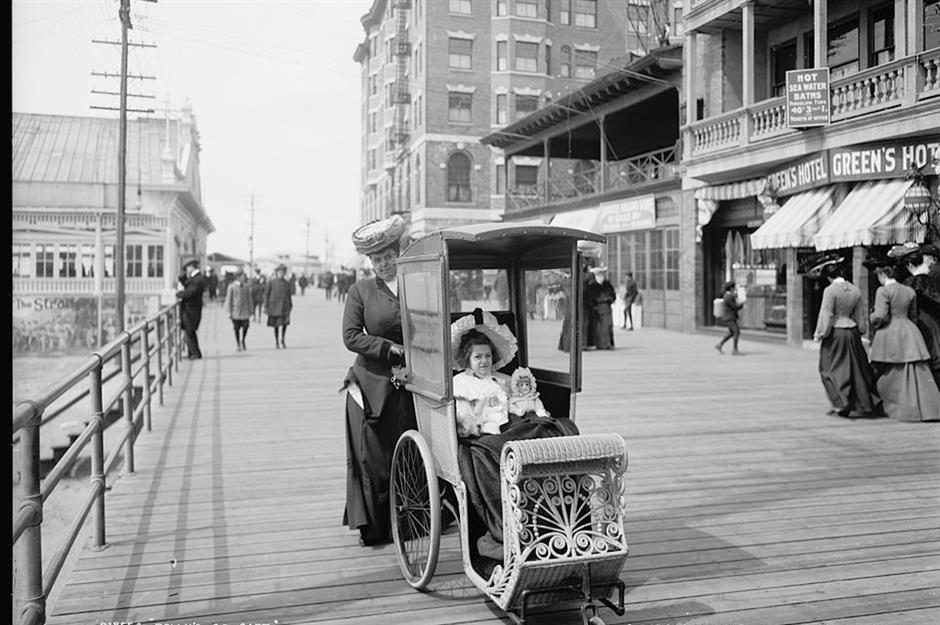
Atlantic City in New Jersey was also a hit with vacationers. The beach-hugging boardwalk, captured here in 1905, drew the most foot traffic, with its hotels, restaurants, and souvenir shops.
Here, a little girl and her lucky doll enjoy a ride on one of Atlantic City's famous 'rolling chairs.'
1908: Orville Wright’s crashed aircraft at Fort Myer, Virginia
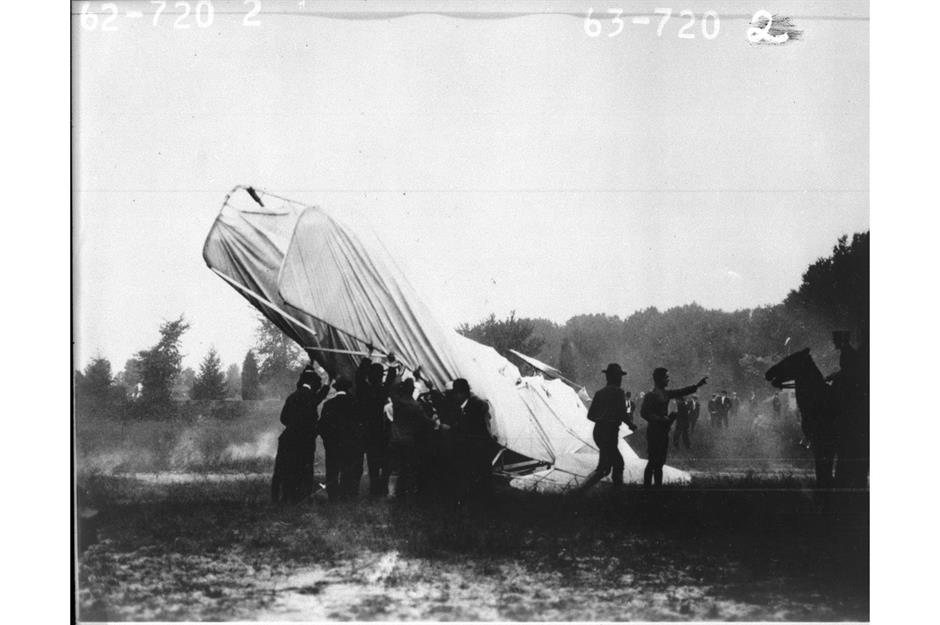
September 17, 1908 made headlines around the world as the day of the very first passenger plane crash death. During a trial to win a contract with the US Army, pilot Orville Wright and his passenger Lieutenant Thomas Selfridge took off in a Wright Flyer (the first type of powered plane) from Fort Myer in Virginia.
Unfortunately, the aircraft (pictured) malfunctioned and pitched nose-first into the ground, injuring both men. Wright recovered but Selfridge died in hospital a few hours later.
c.1910: husky sledding in Alaska
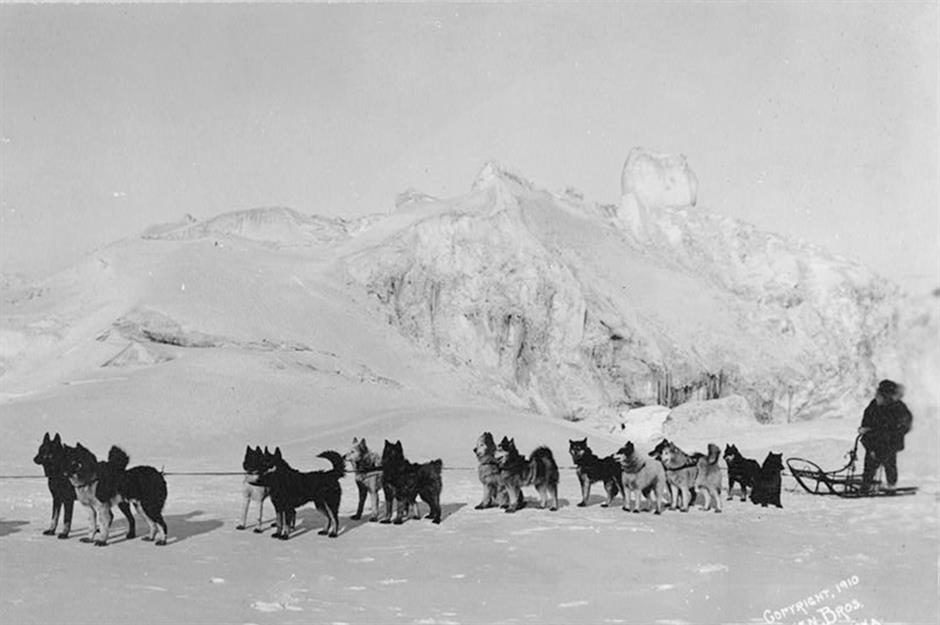
This vintage photo from the Frontier State was taken around 1910. It captures the winning team from the third All Alaska Sweepstakes, a dog-sledding event held in the state between 1908 and 1917.
Dog mushing is still a popular activity in Alaska today with major events like the annual Iditarod Trail Sled Dog Race.
1910: a palm-lined road in California
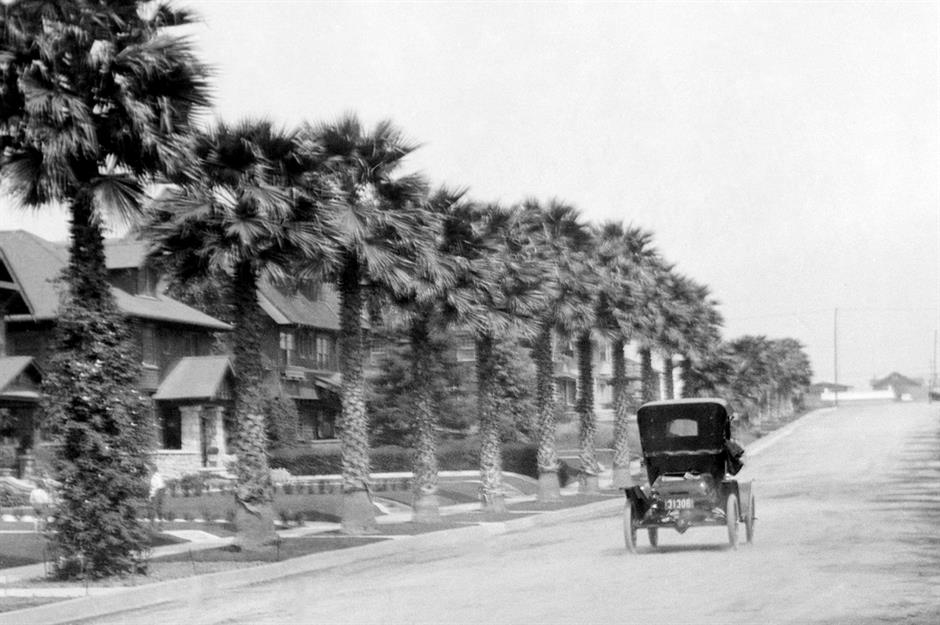
America is the land of the road trip today, but in the early 20th century car ownership was still rare (though increasingly less so). The United States was mostly criss-crossed by dirt roads, such as this one in Southern California.
1911: a marathon runner in Washington DC

This shot is of early Washington DC marathon runner Henry Elphinstone. The event took place back in 1911, by which time having photographers at major competitions and occasions was commonplace.
Elphinstone runs down Constitution Avenue and you can see the Beaux-Arts-style Russell Senate Office Building to the left.
1911: opening day at the New York Public Library
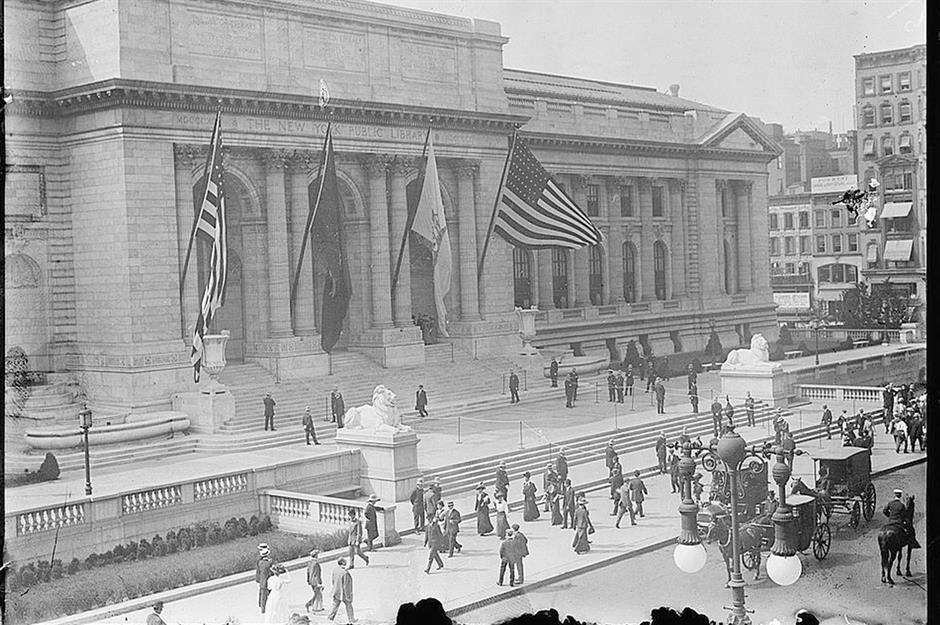
A landmark day for New York City is captured here. On May 23, 1911 the city opened the doors to the New York Public Library – an elegant Beaux Arts-style building on Fifth Avenue.
At the time, it was the largest marble building in the country and its bold lion sculptures and grand façade drew photographers from all over town.
1915: suffragist in New York City
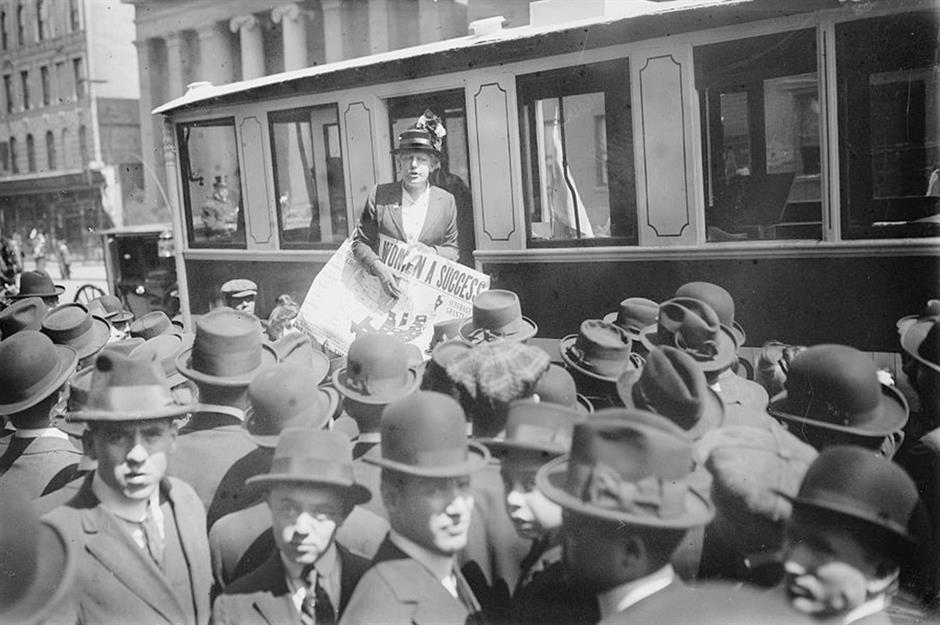
This poignant photo shows New York City from another perspective. Here, circa 1915, suffragist Elizabeth Selden White Rogers is seen promoting women's right to vote at a mobile platform in the Big Apple. A crowd of men look on.
Read on to discover the most powerful photos in US history...
Comments
Be the first to comment
Do you want to comment on this article? You need to be signed in for this feature